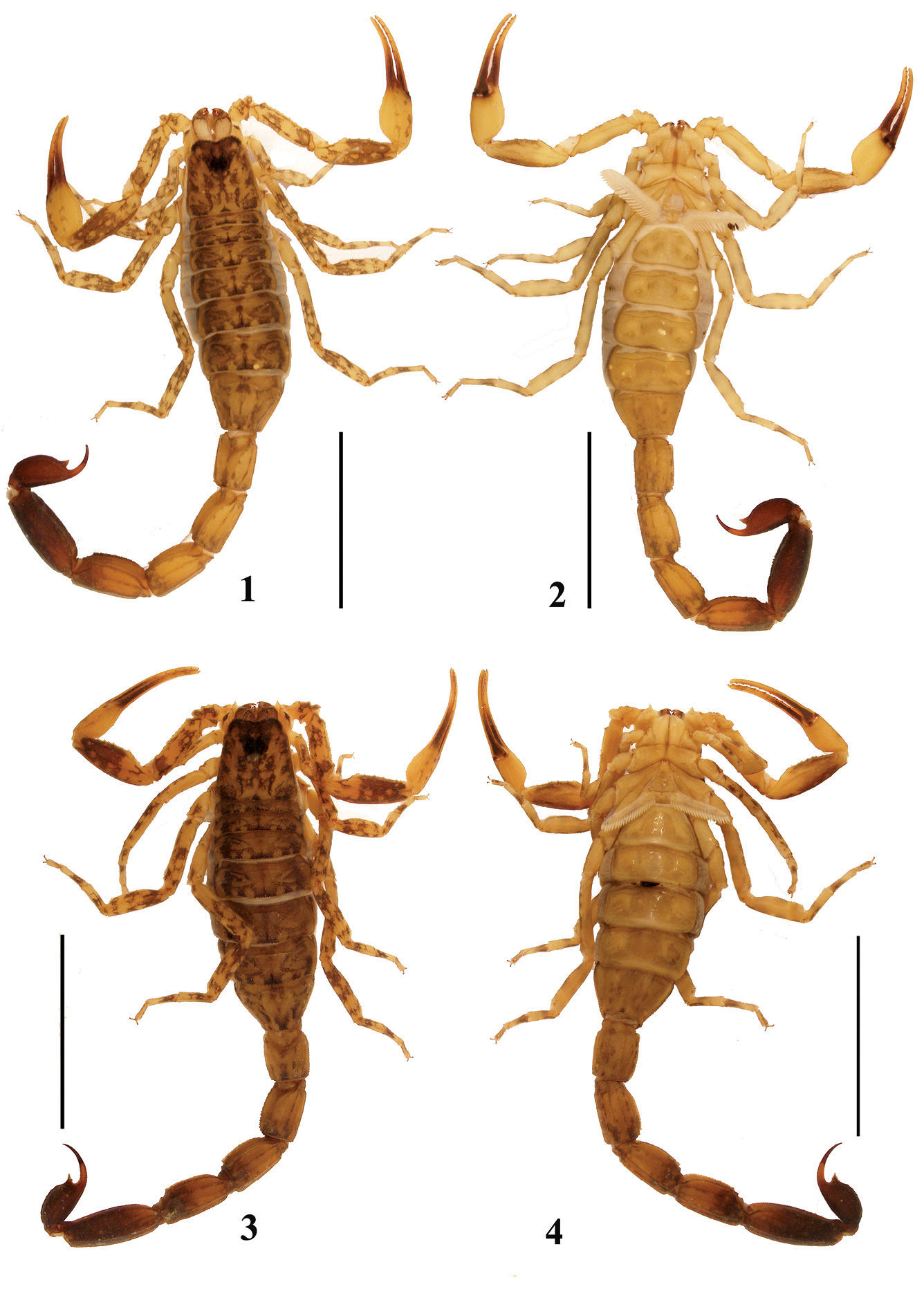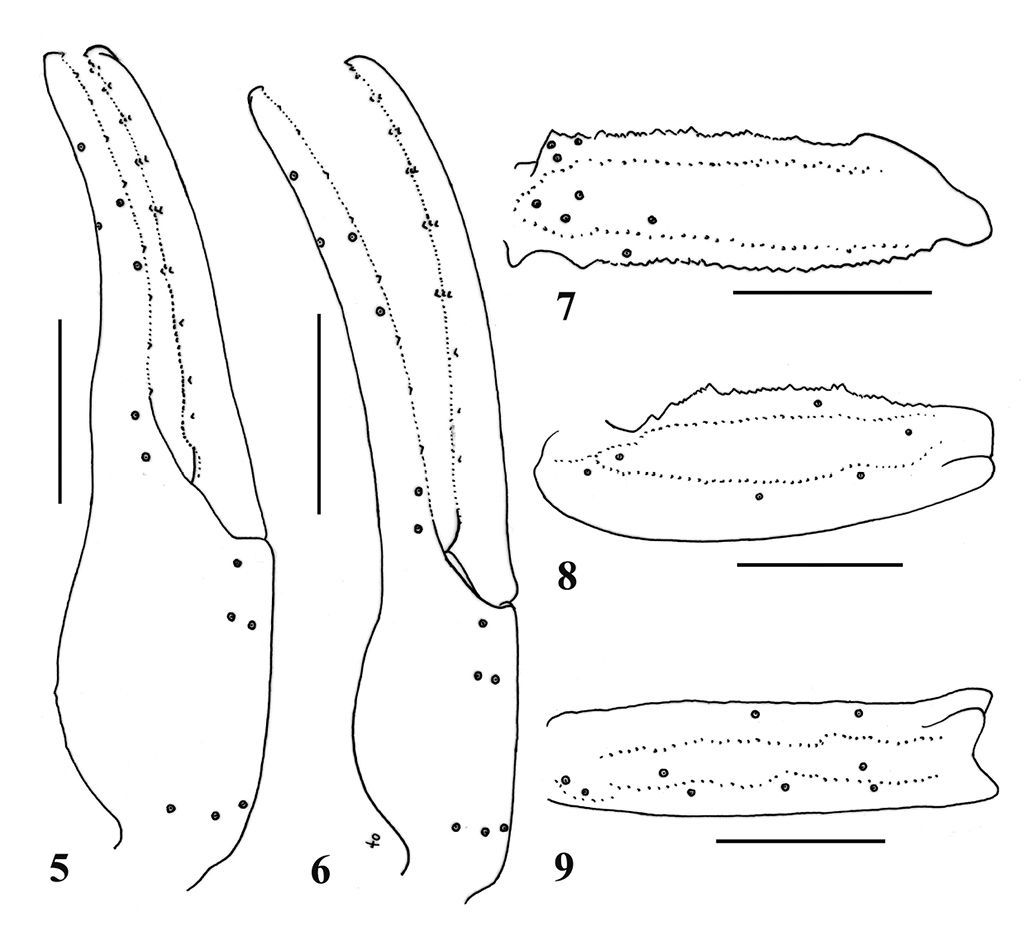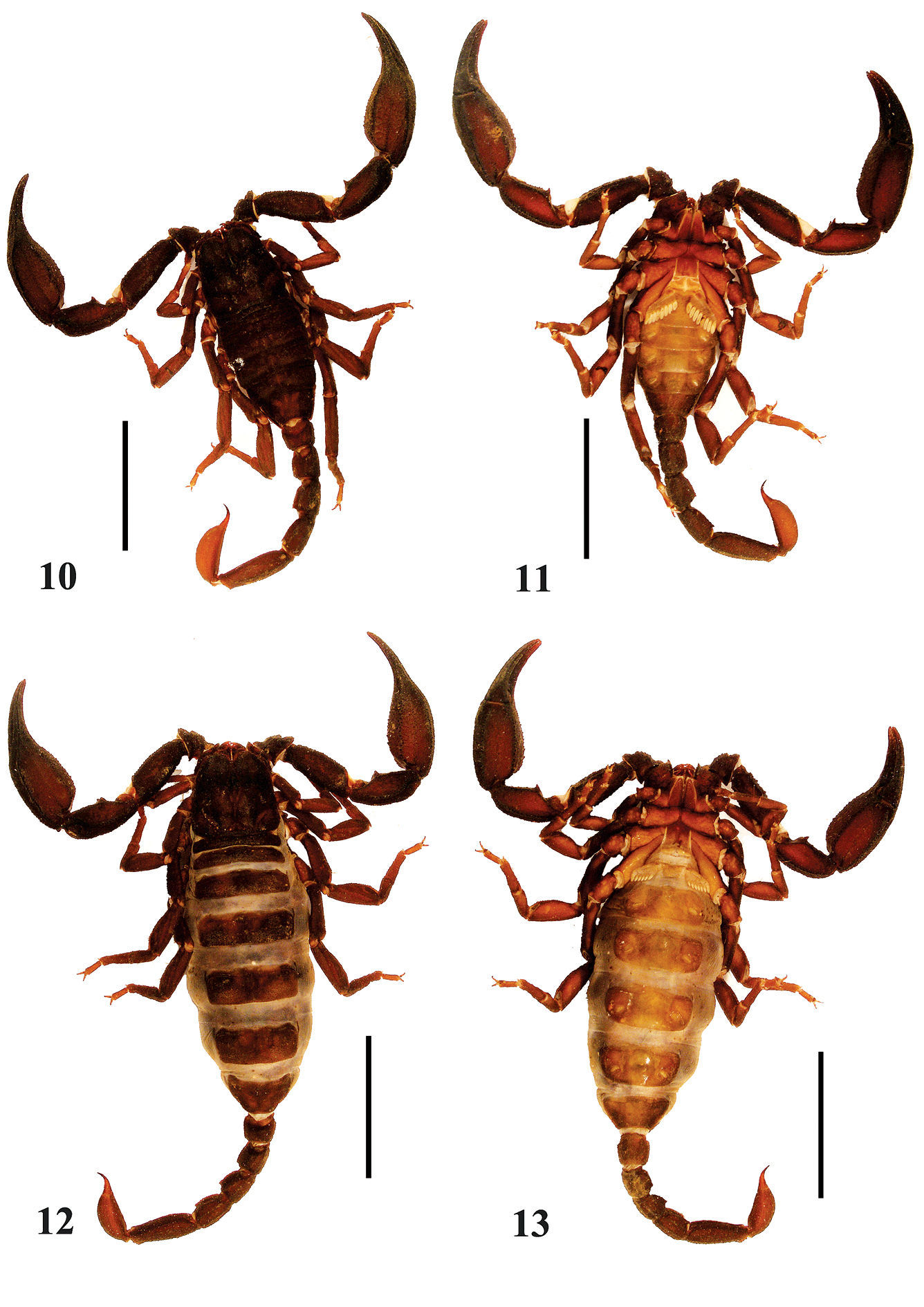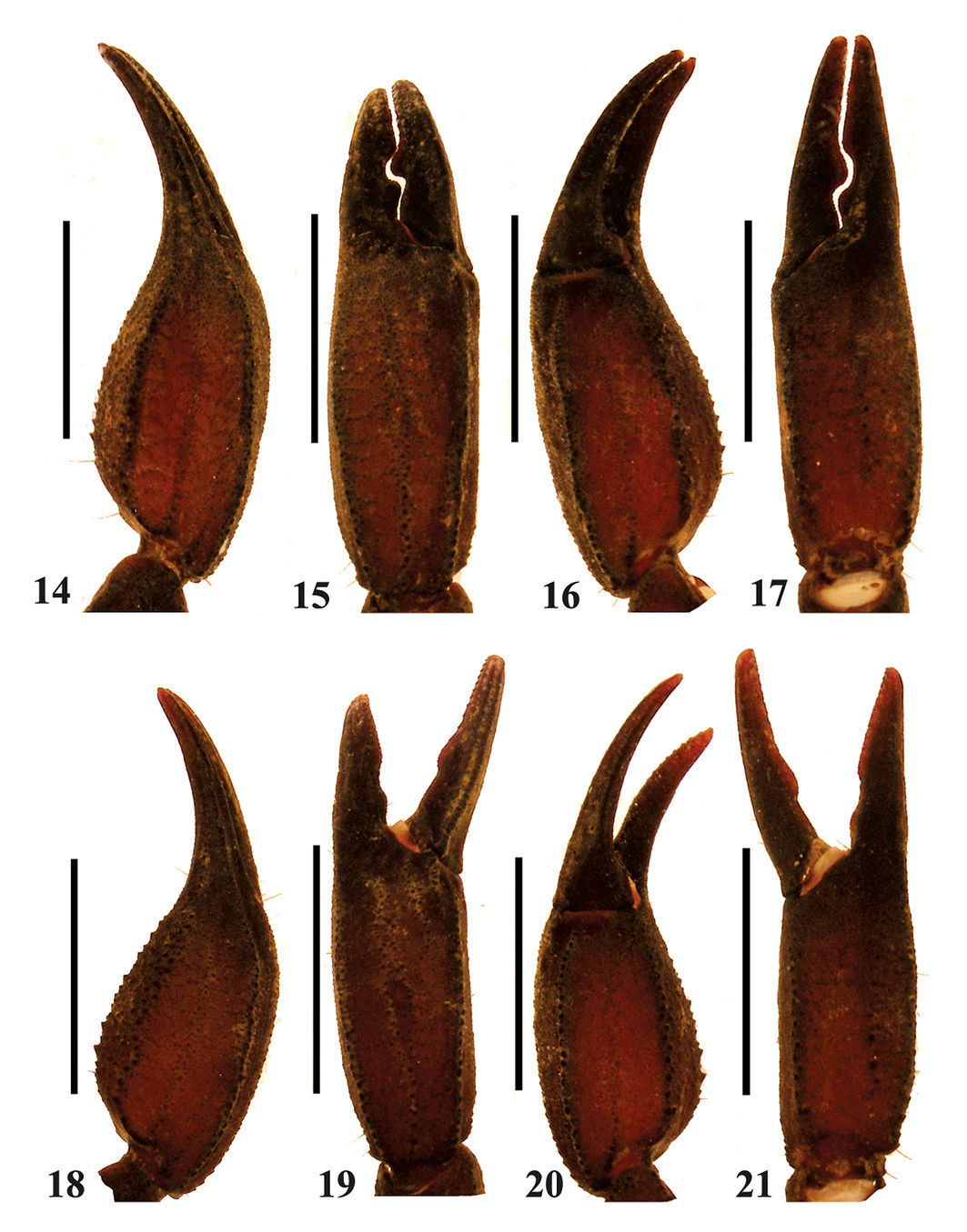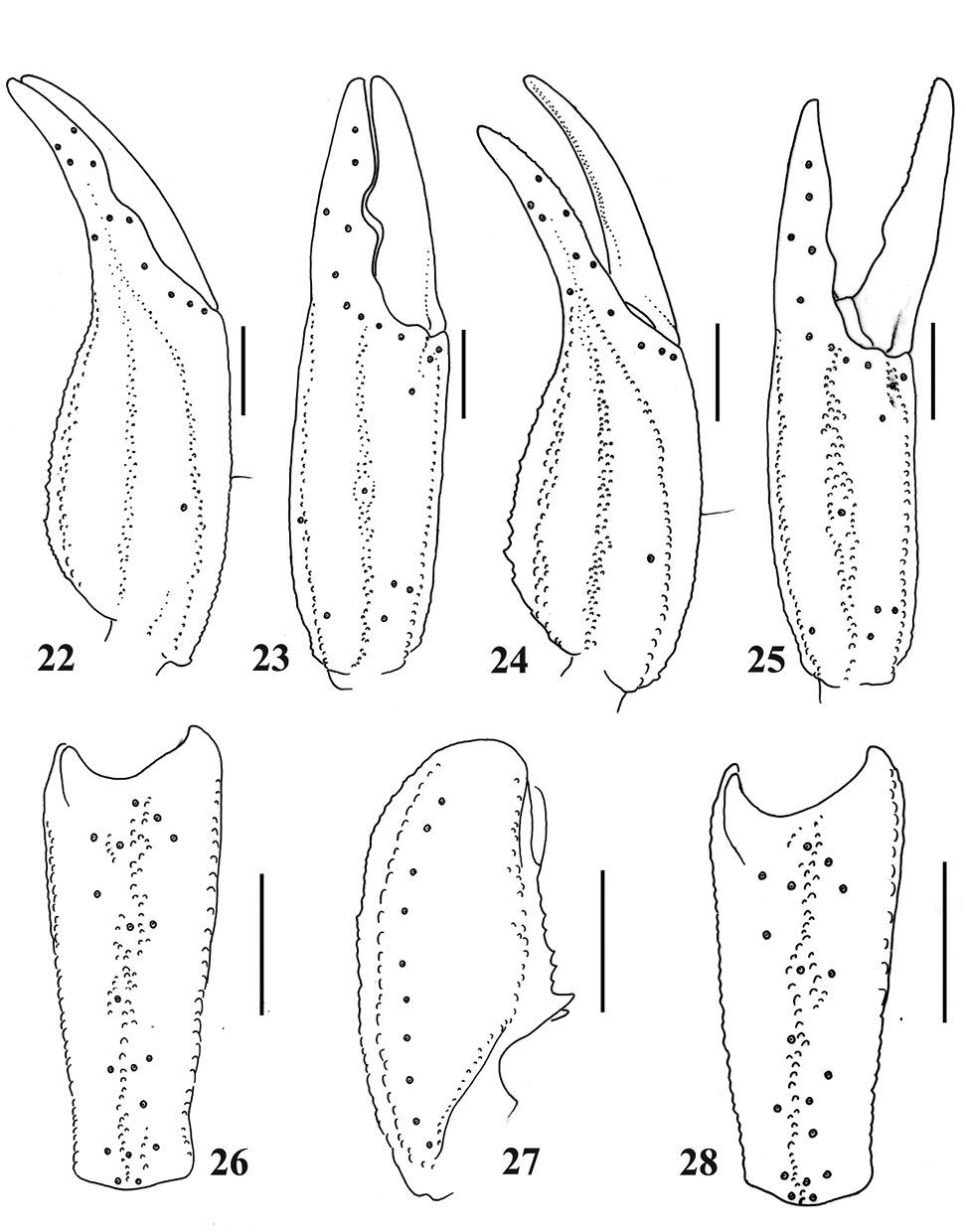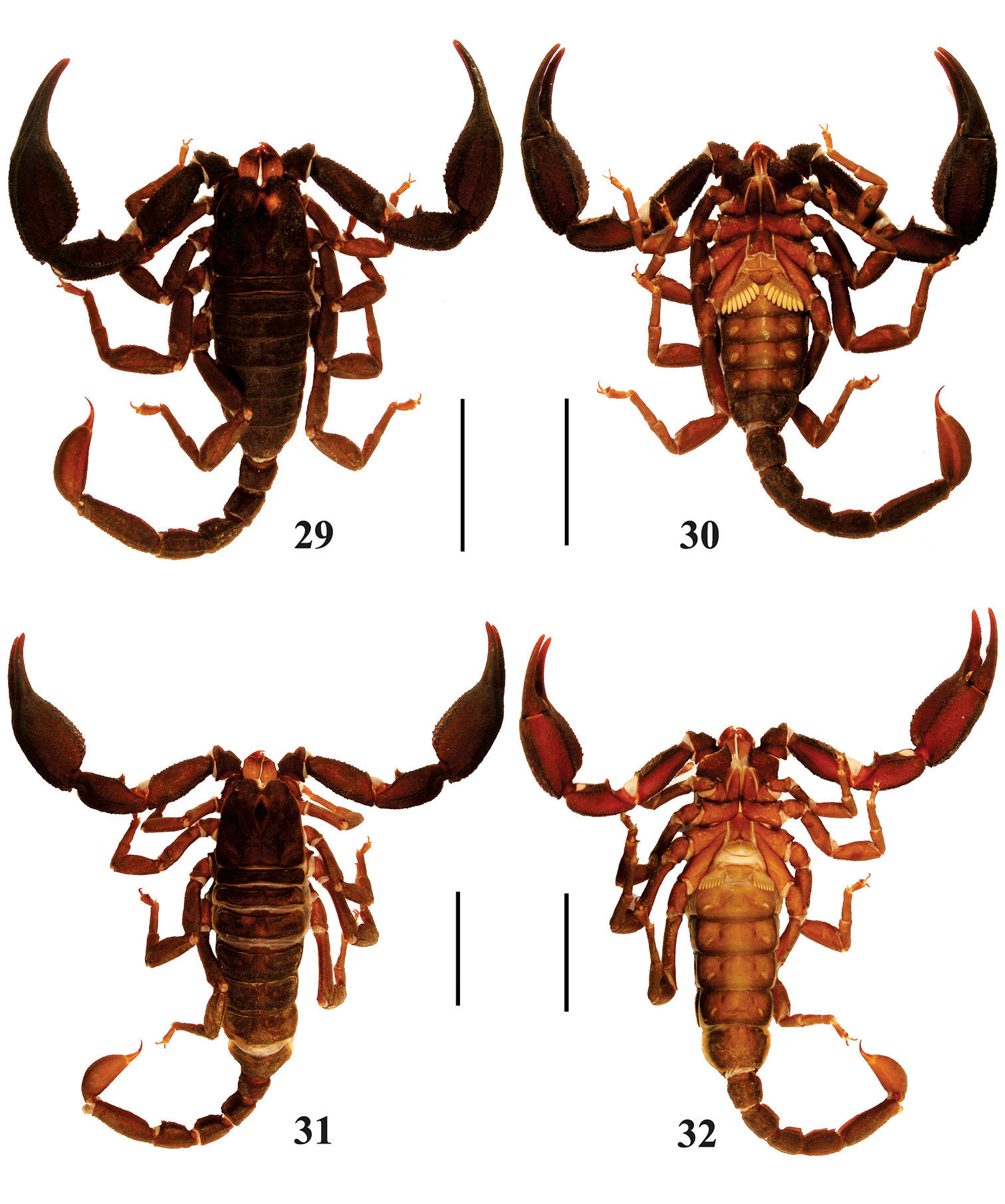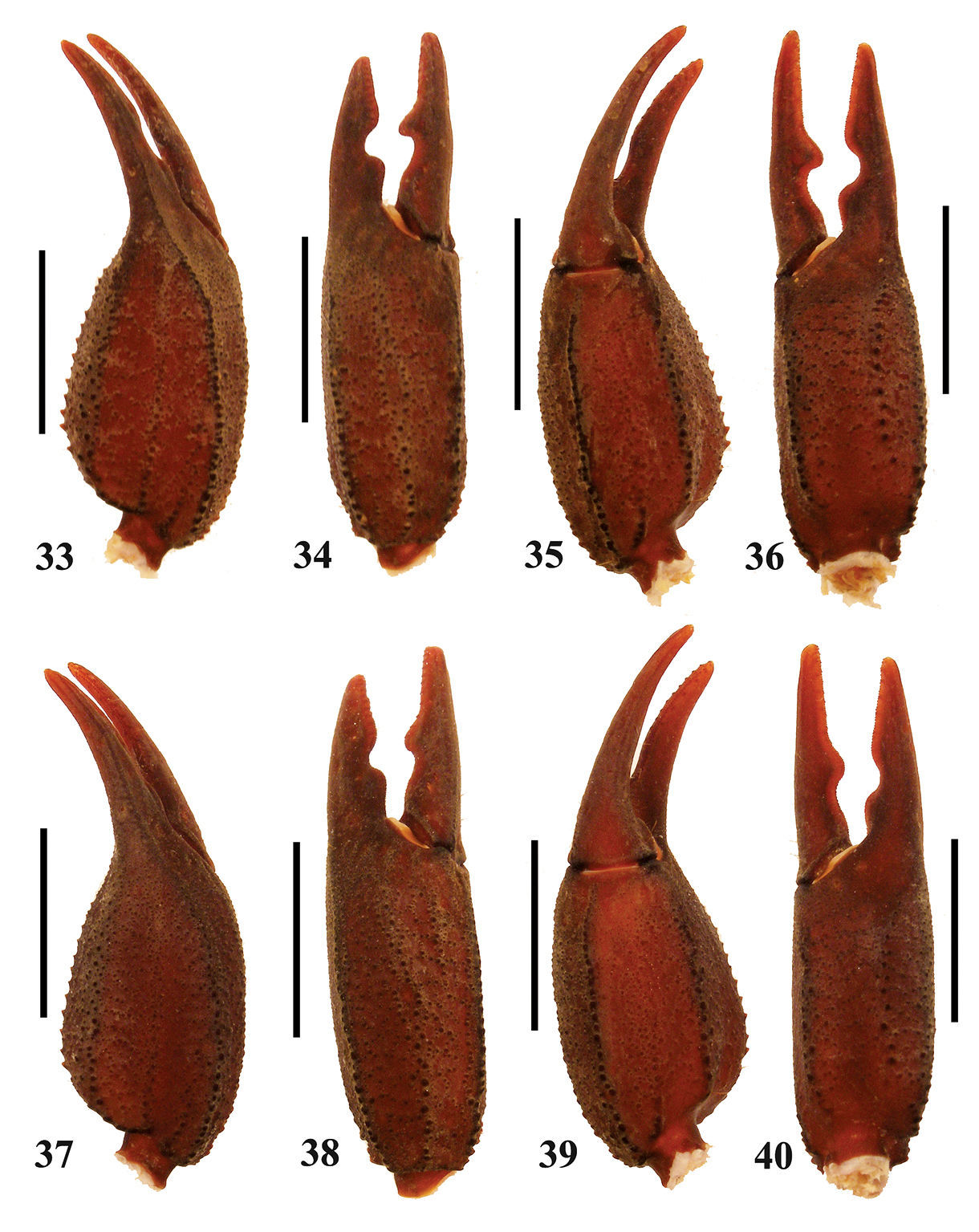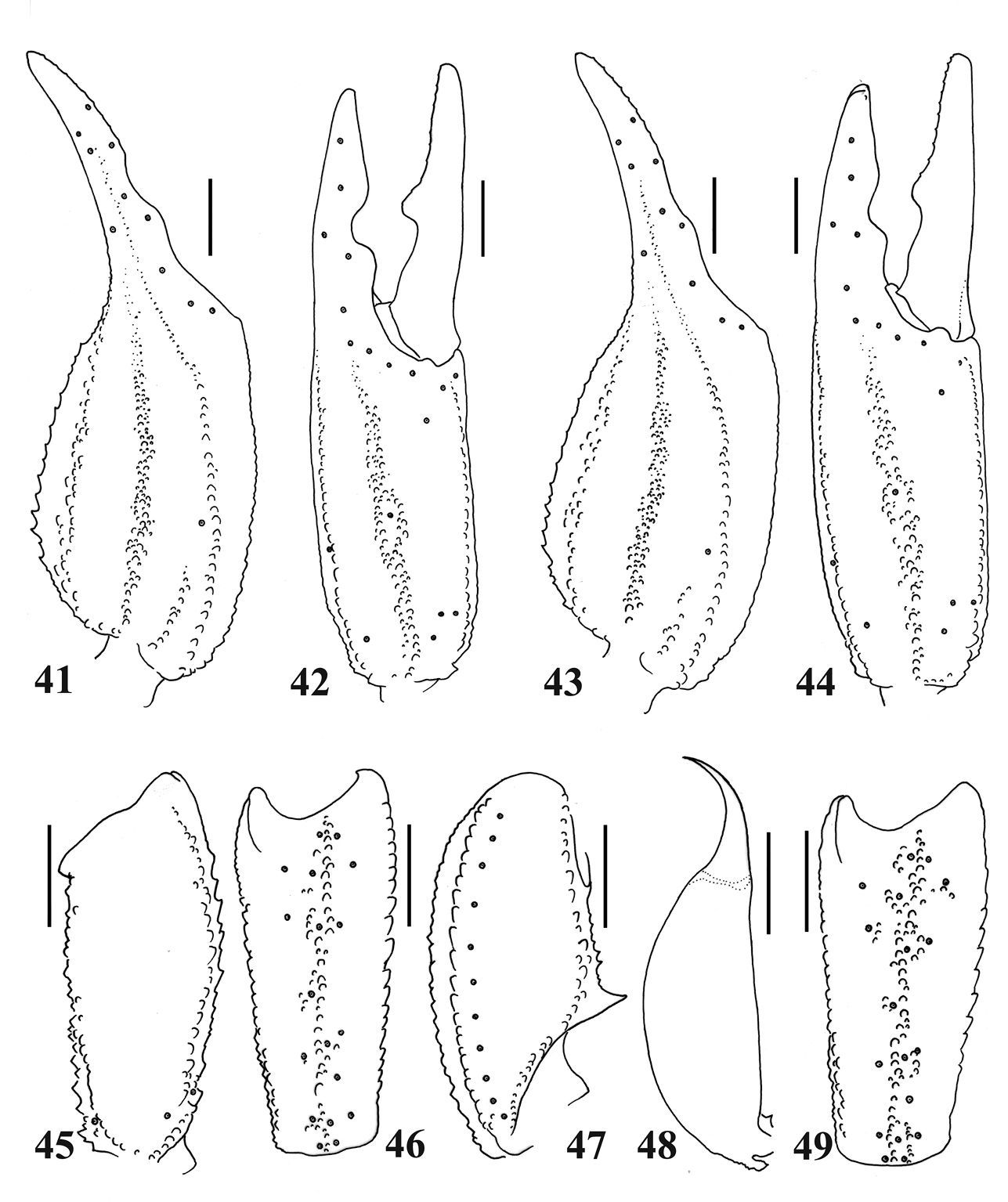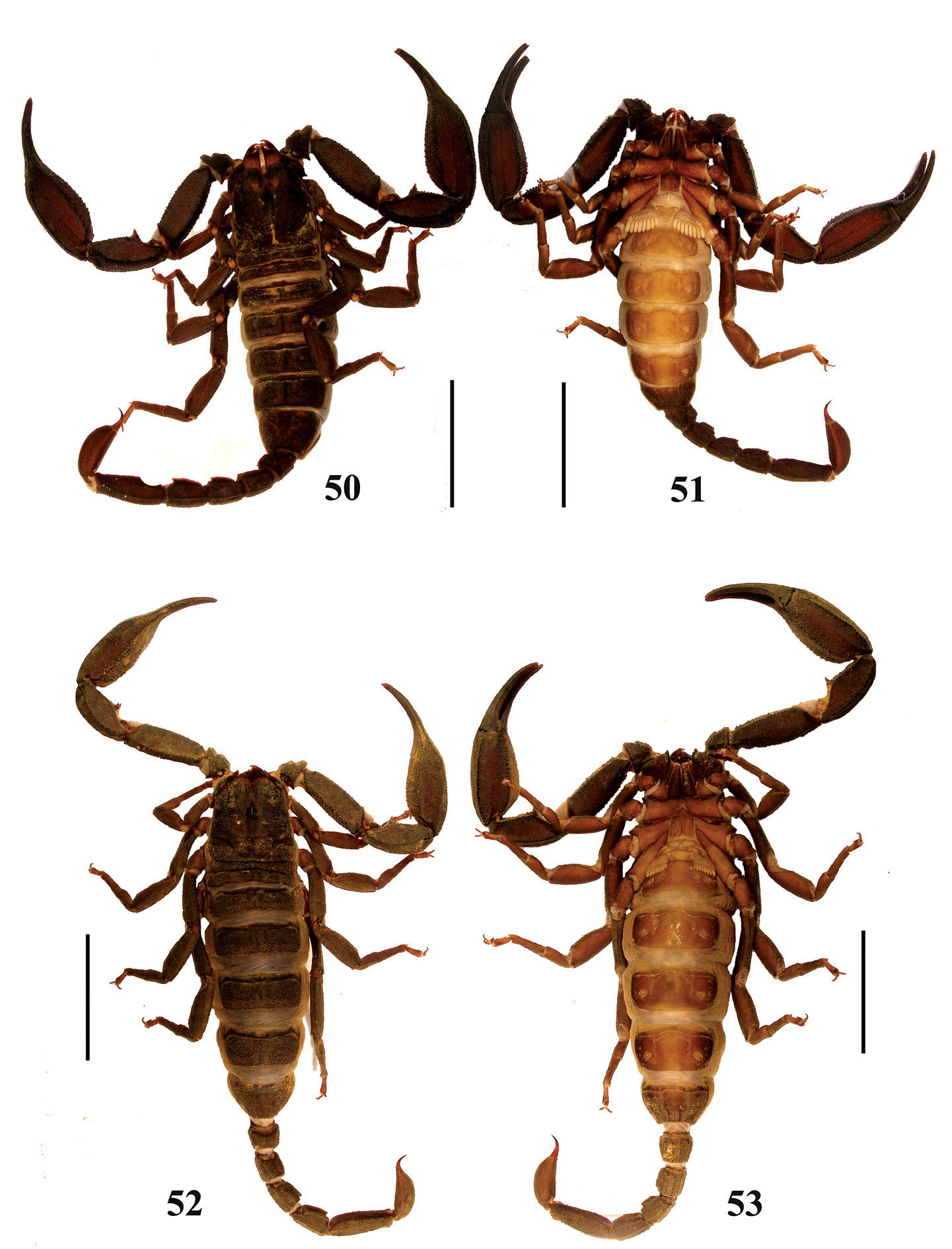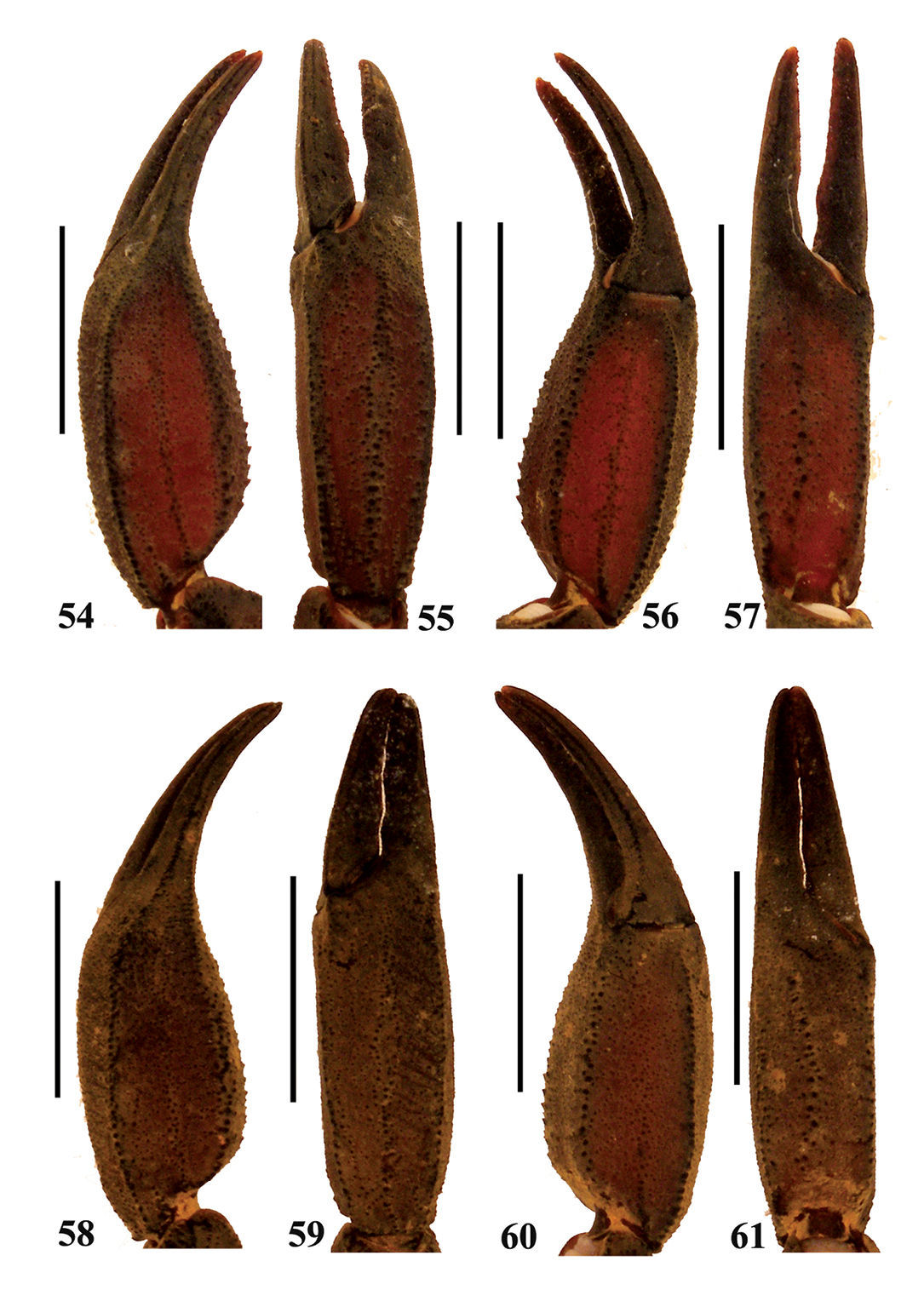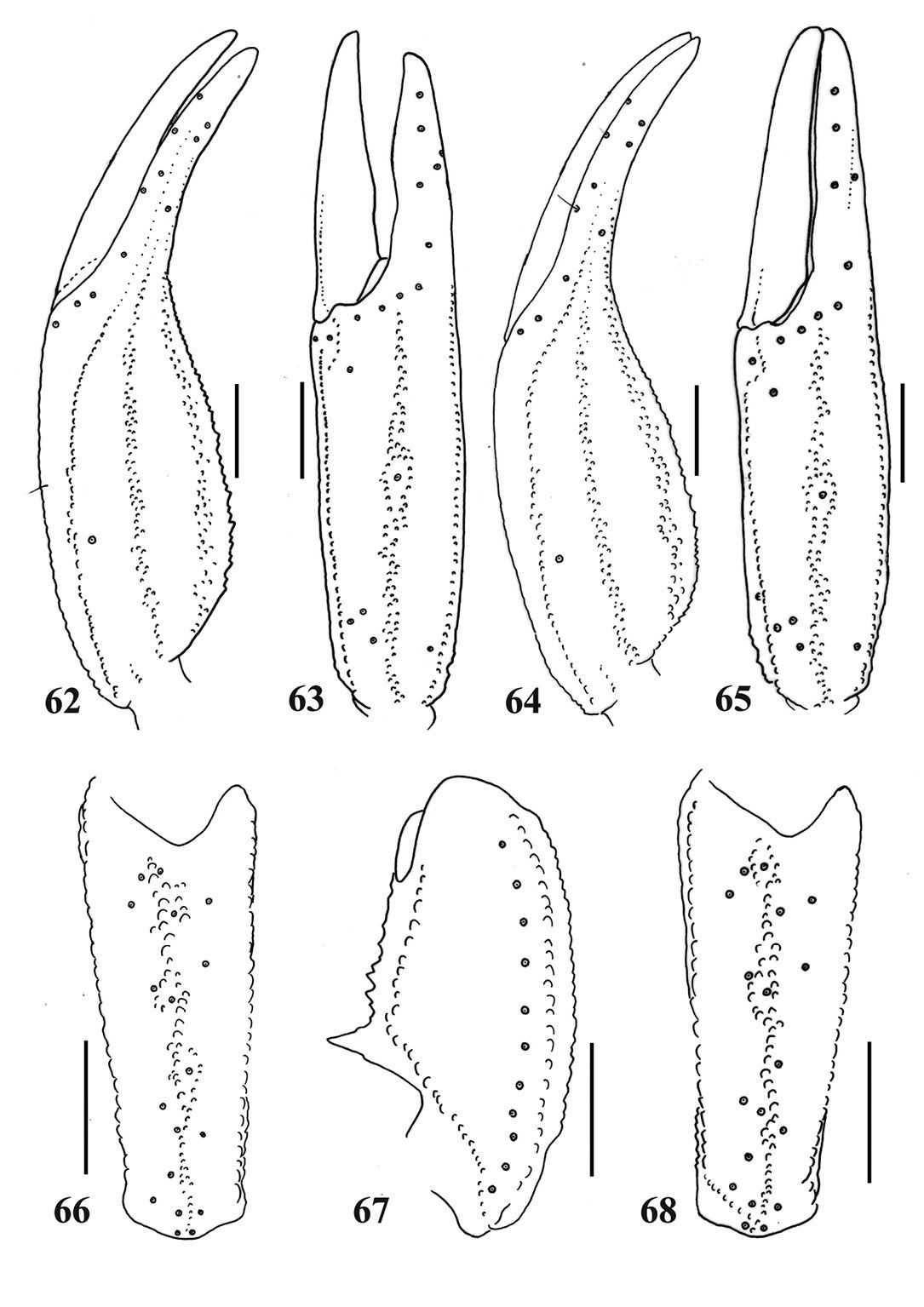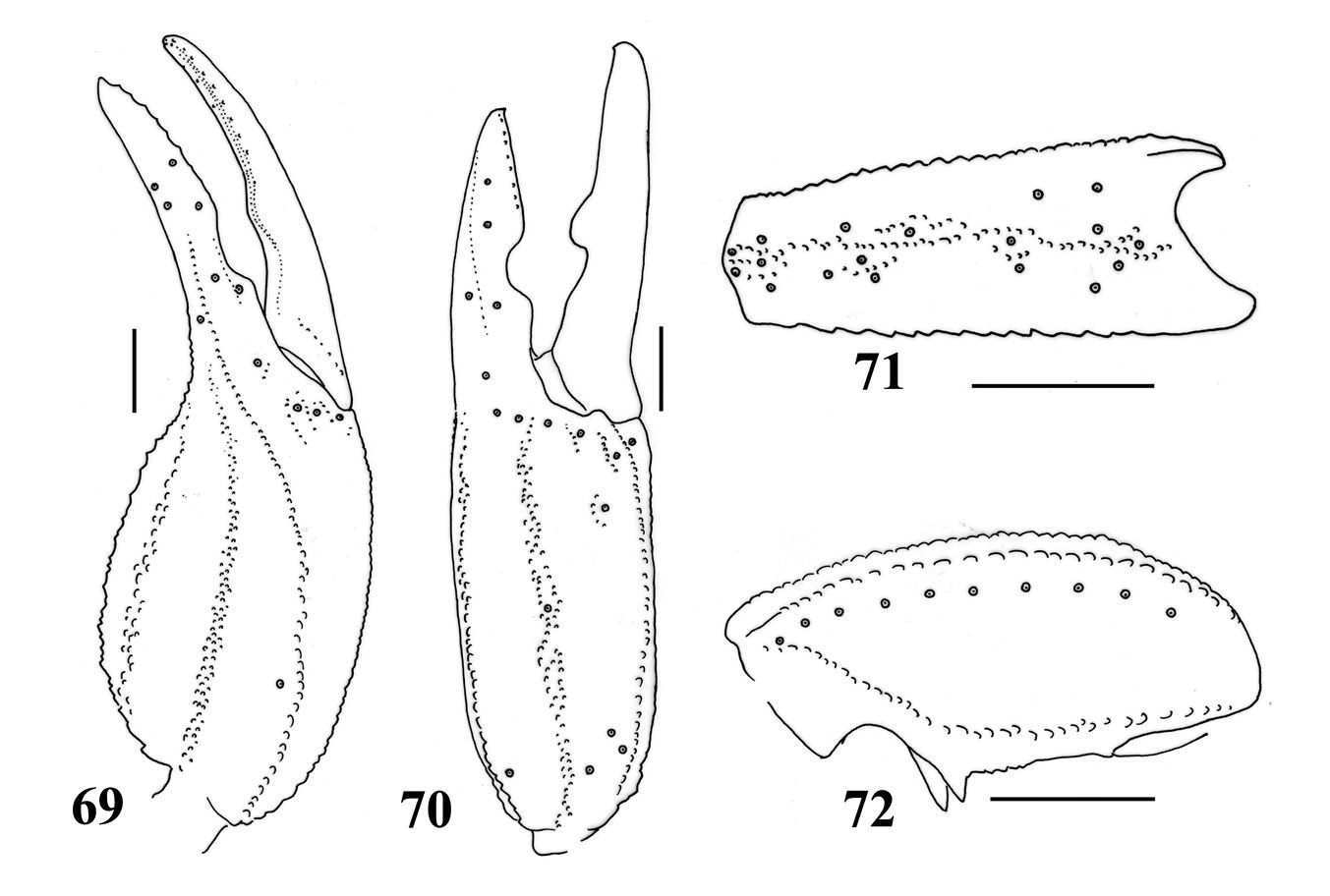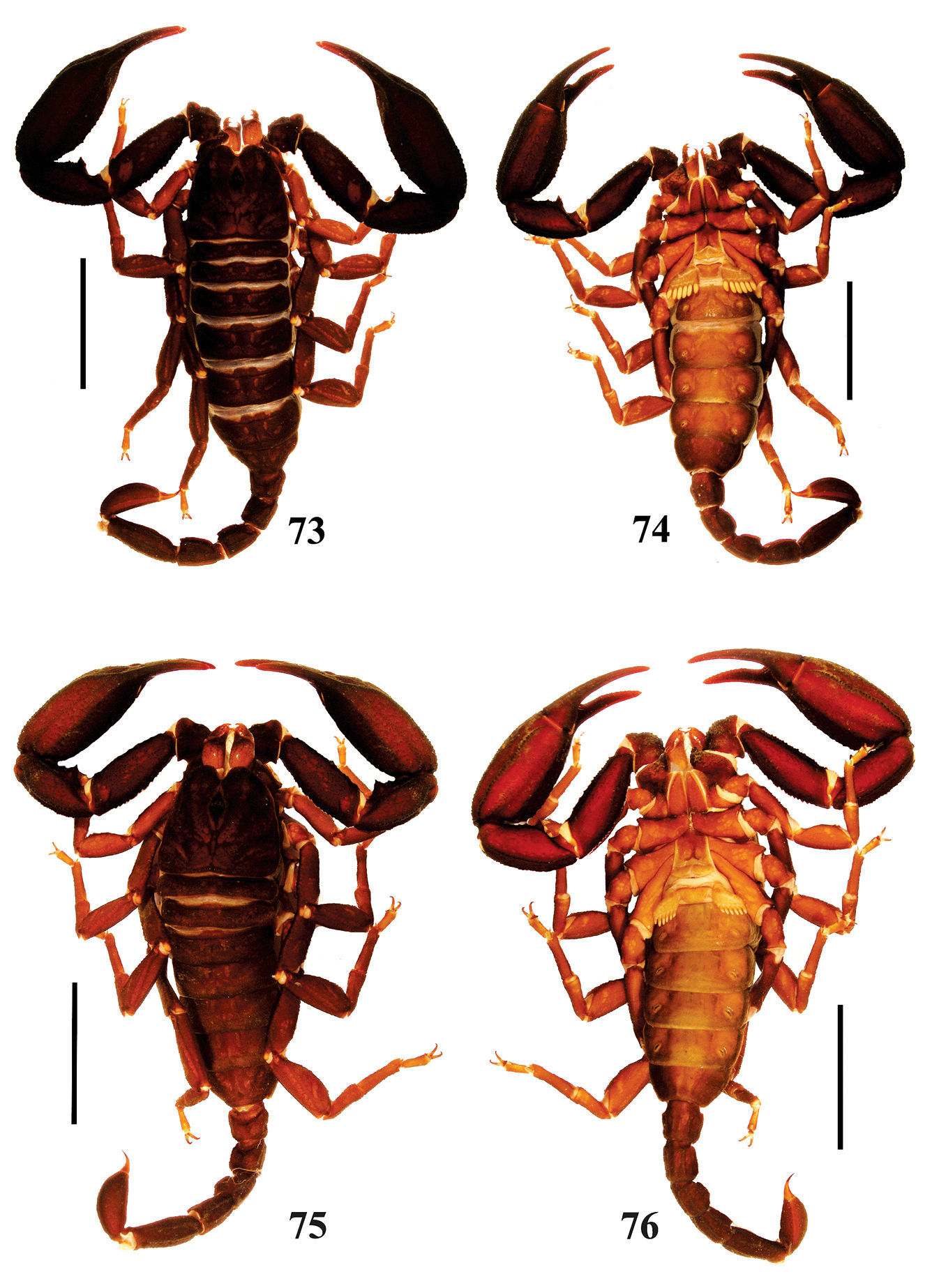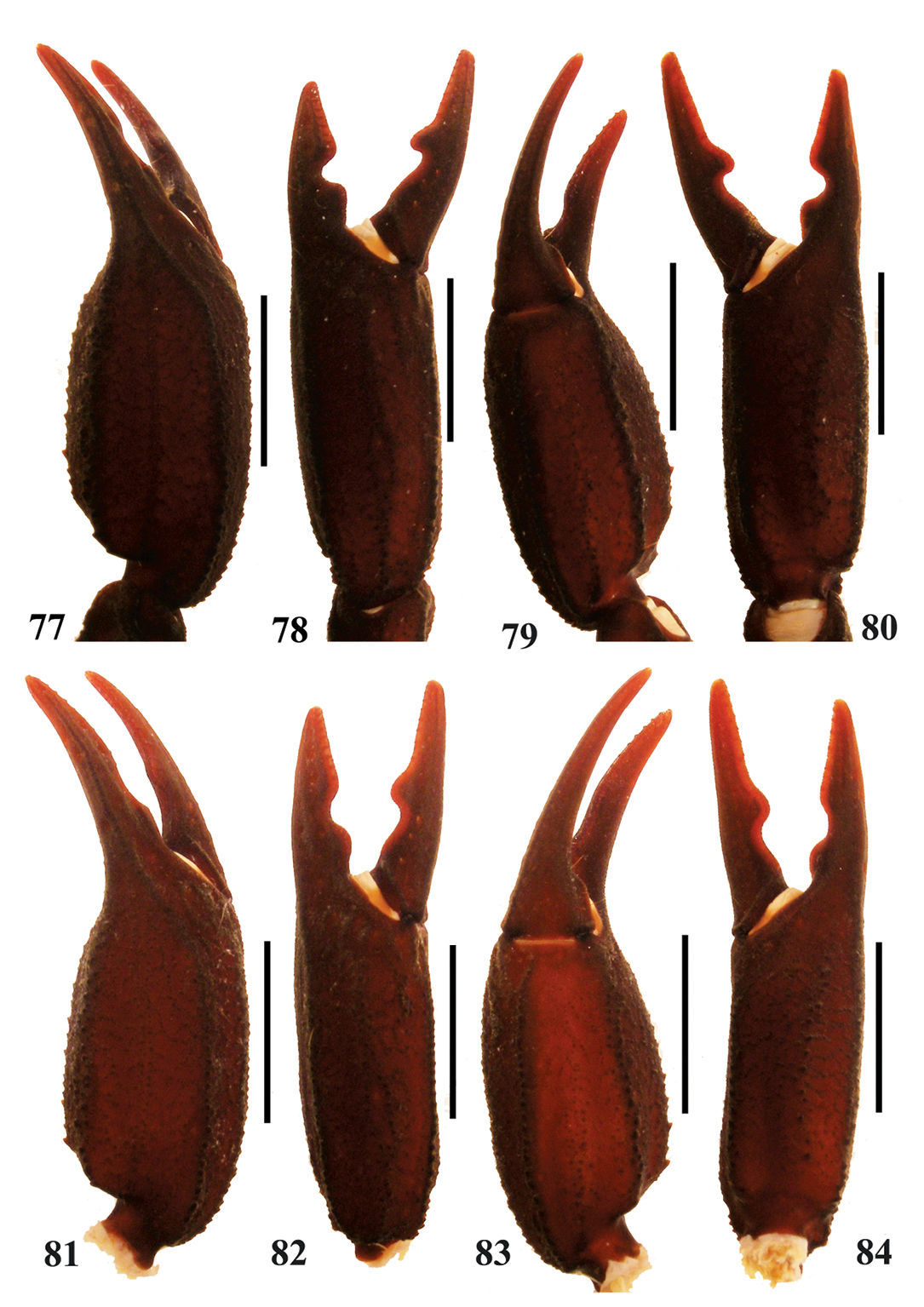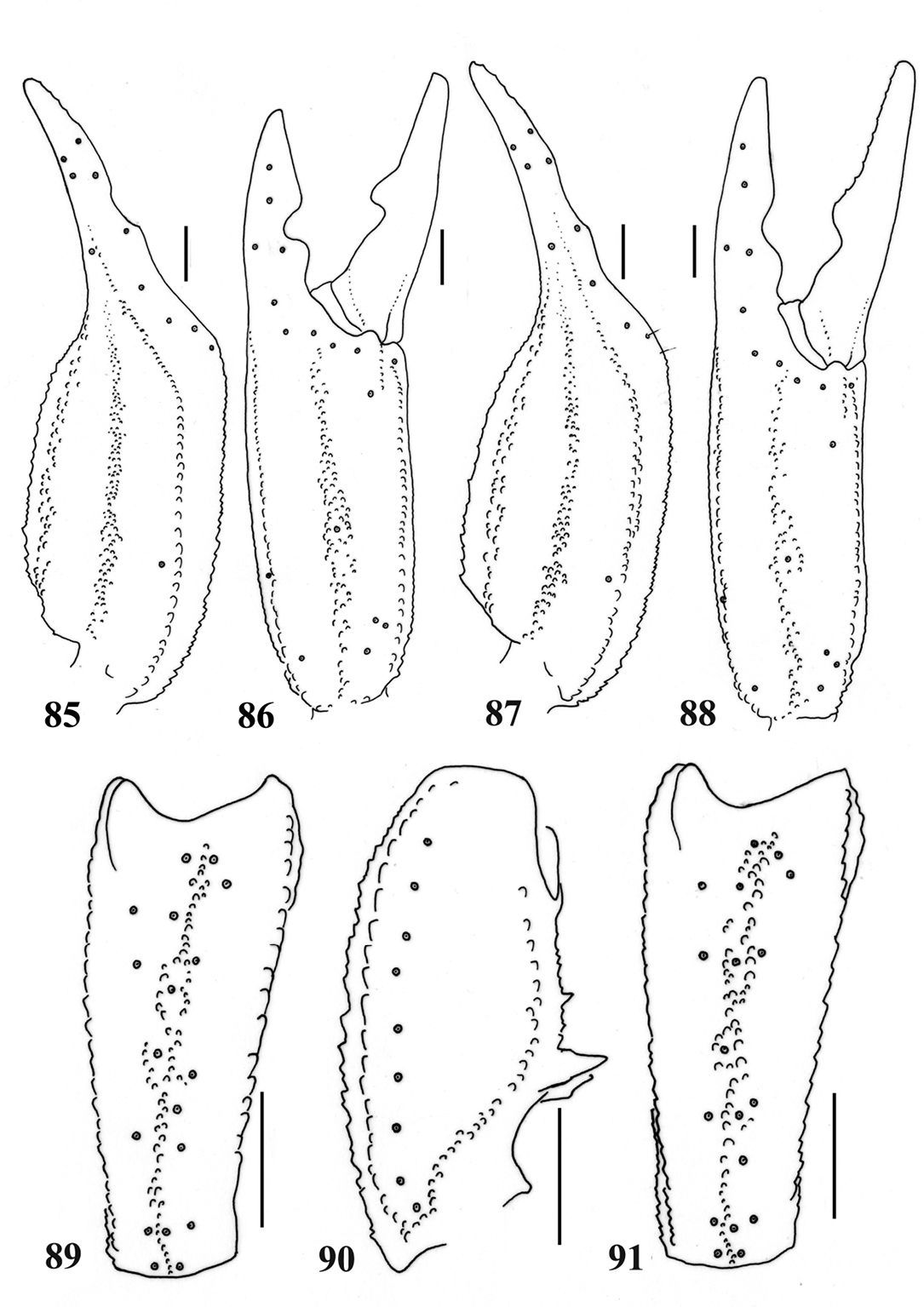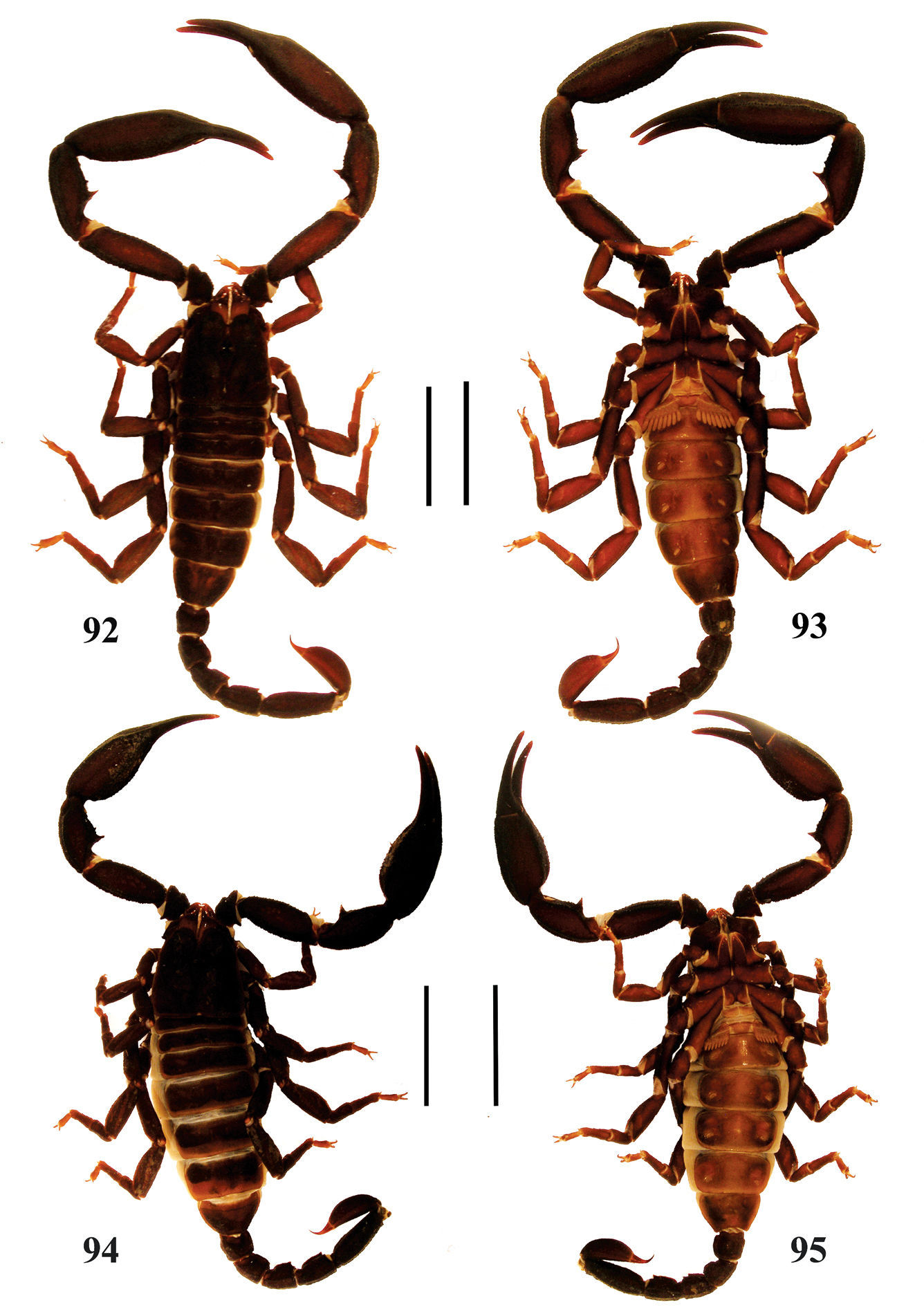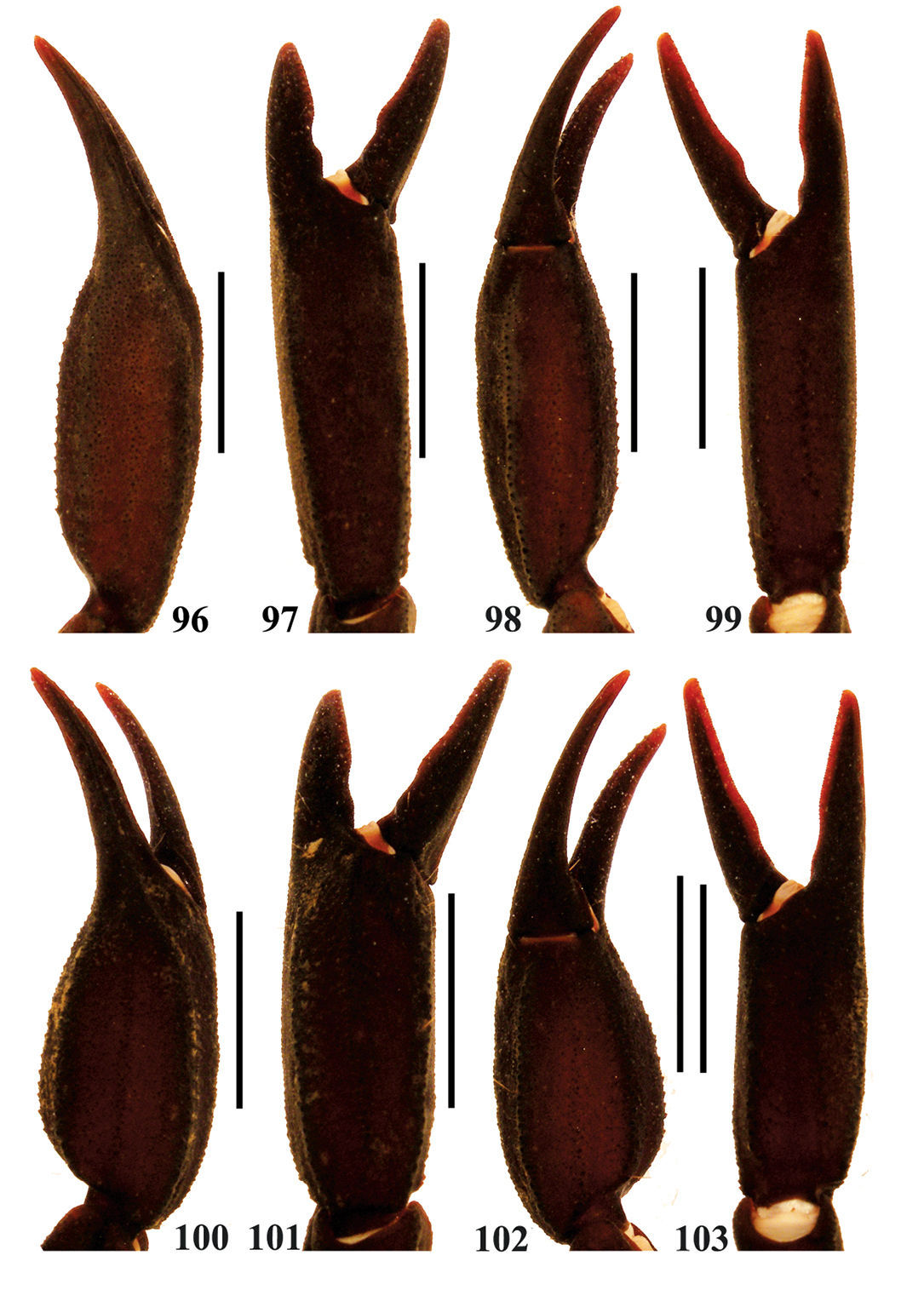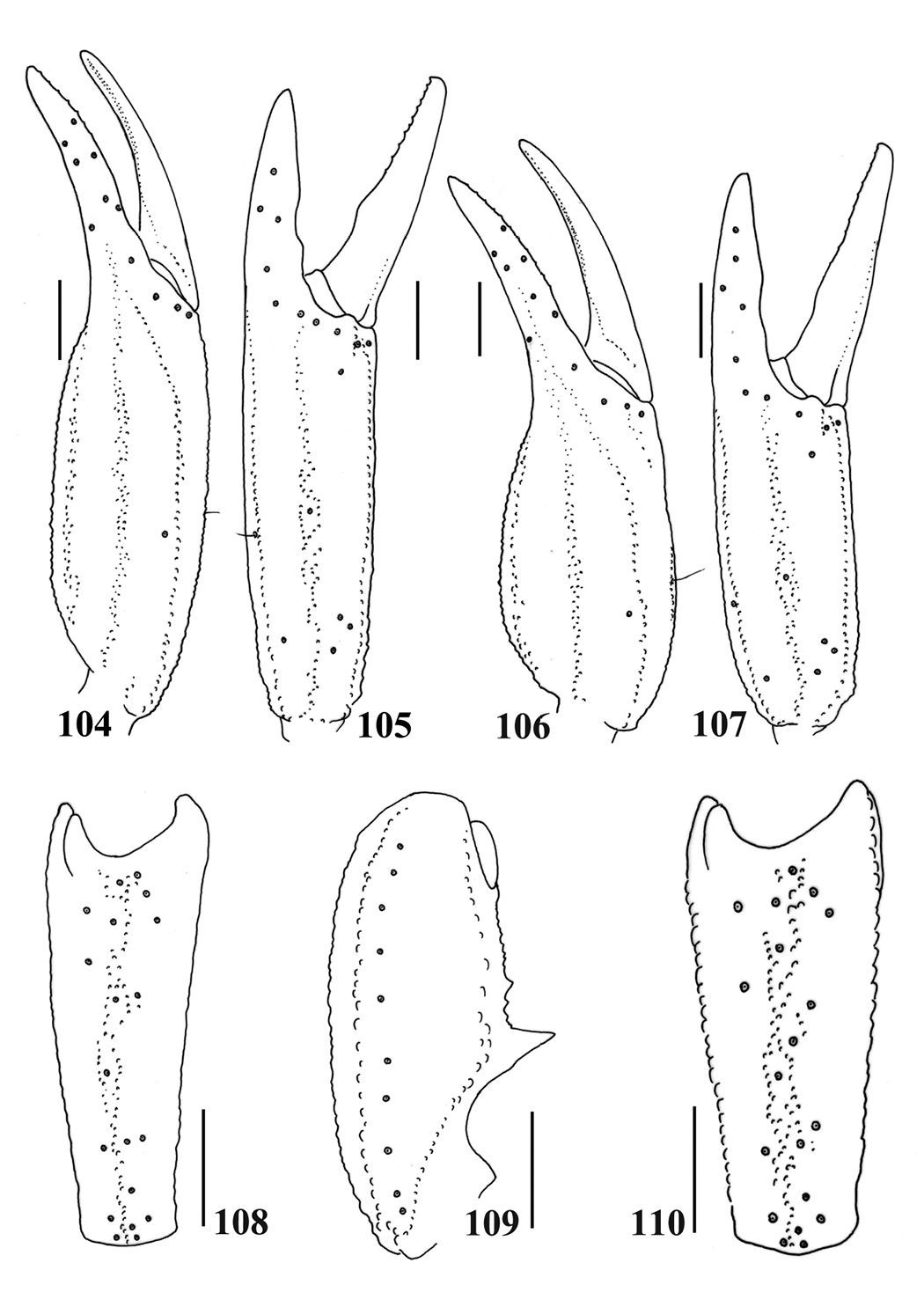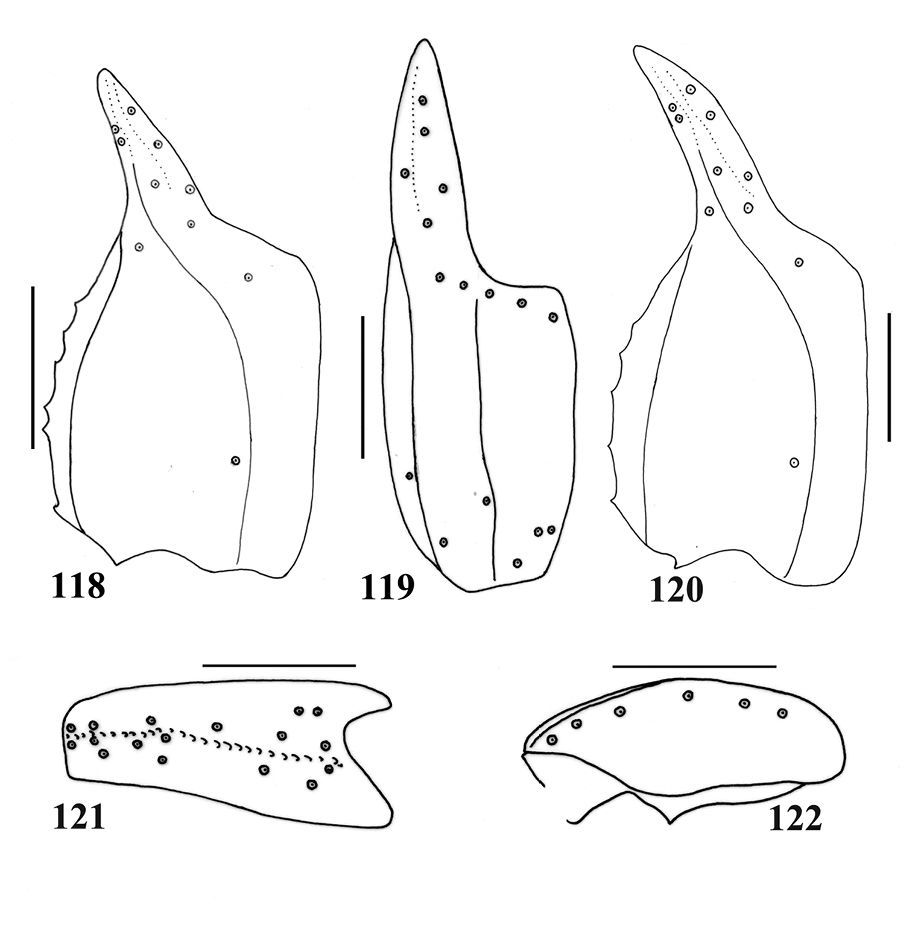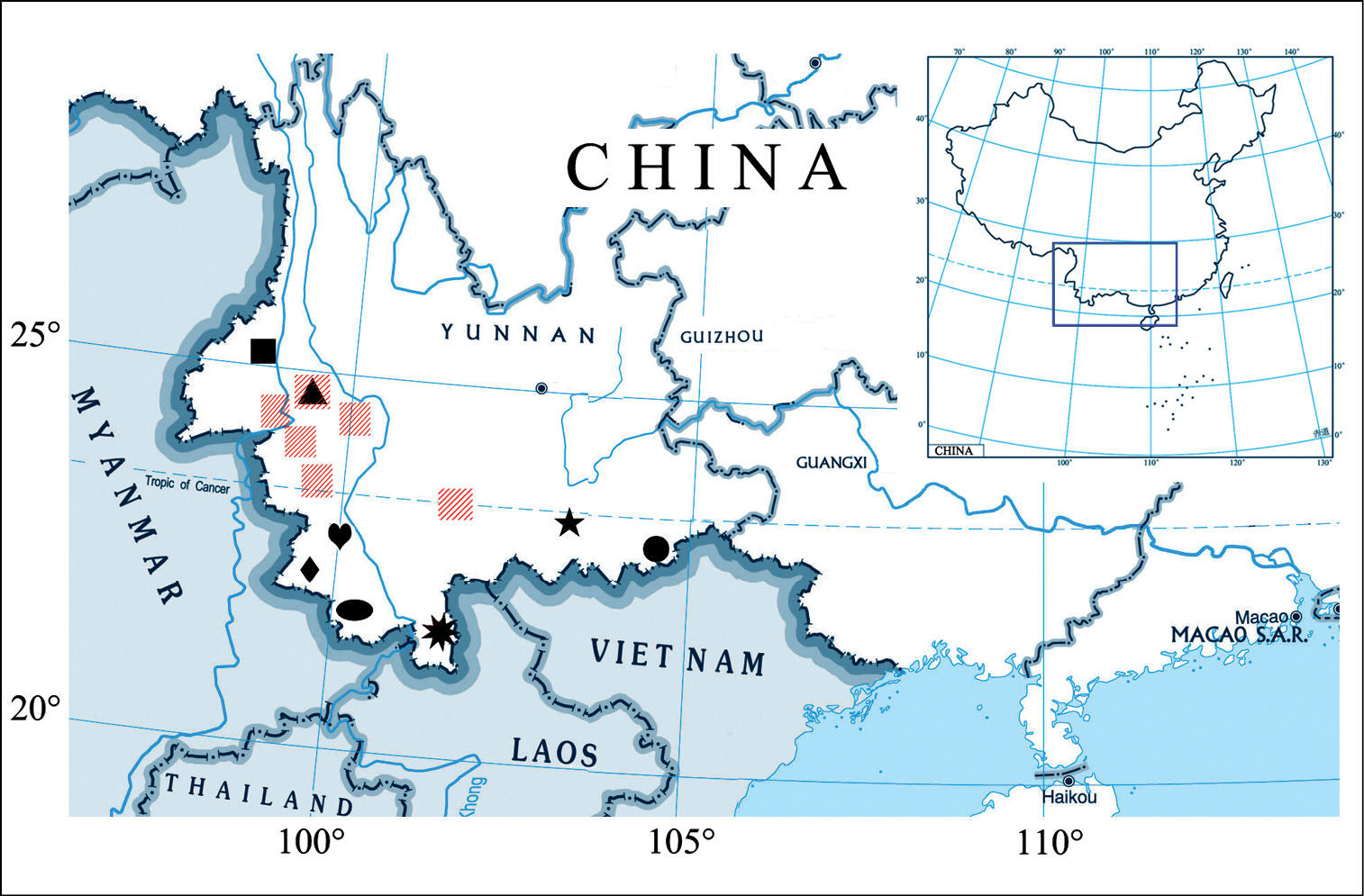(C) 2010 Zhiyong Di. This is an open access article distributed under the terms of the Creative Commons Attribution License, which permits unrestricted use, distribution, and reproduction in any medium, provided the original author and source are credited.
For reference, use of the paginated PDF or printed version of this article is recommended.
We present an identification key to the scorpion species of Yunnan (China) with notes on the distribution and ecology. Euscorpiops kubani is recorded for the first time for China. The redescriptions of Euscorpiops shidian and Euscorpiops kubani are provided. The number of known scorpion species from Yunnan is raised to nine.
Buthidae, Euscorpiidae, new record, taxonomy, redescriptions, Yunnan, China
Yunnan province located in the junction of world’s two
major biodiversity hotspots (21°8'32"–29°15'8"N,
97°31'39"–106°11'47"E), is the transition area from the high altitudes
of Qinghai-Tibet plateau to low altitude peninsular Malaysia. Almost all
of the terrestrial ecosystems can be found in Yunnan, including
forests, shrubs, meadows, swamps and deserts (
The terrestrial diversity in Yunnan can meet the specific habitats demand of different species (
There are nine species, belonging to two families: Buthidae: LychasC.L. Koch, 1845, Euscorpiidae: Euscorpiops and Scorpiops Peters, 1861have been recorded for this area. With seven species of Euscorpiops occur in Yunnan province more than a third of the total known species of this genus in the world (7/19); all them with similar coloration, morphology and close distribution.
Material and methodsIllustrations and measurements were produced using a
Motic K-700L stereomicroscope with a drawing device and an ocular
micrometer. The photos were taken with an Olympus C7070 camera.
Measurements follow
Genus Lychas C.L. Koch, 1845
Figures 1–9
India orientali, UZMD.
Lost.
Shidian District, 17/VIII/2010, Dahe Jiang, Chaowu Yang and Zhiyong Di leg, 11 females, 3 males, 2 juveniles (MWHU, Ar.-MWHU-YNSD1010–15); Shidian District (24.42°N, 99.24°E), VIII/2008, Heng Xiao leg, 7 females, 7 males, 6 immatures (MWHU, Ar.-MWHU-YNSD0801–20); Longling District (24.47°N, 98.56°E), 18/VIII/2010, Wenxin Li, Hui Liu, Xiaohua He and Zizhong Yang leg, 14 females, 3 males, 4 juveniles (MWHU, Ar.-MWHU-YNLL1010–20); Gengma District, 6/VIII/2004, Zizhong Yang and Yuhua Yang leg, 2 males (BHDC, Ar.-BHDC-YNGM0401–02); Yun District, 21/VII/2003, Zizhong Yang and Benyong Mao leg, 2 males (BHDC, Ar.-BHDC-YNYX0301–02); Yongde District, 20/VII/2009, Benyong Mao leg, 1 female, 3 males (BHDC, Ar.-BHDC-YNYD0901–04); Mojiang District, Tongguan town, 22/XI/2010, Dongming Luo leg, 2 males, 5 females, 1 juvenile (MWHU, Ar.-MWHU -YNMJ1001–08).
(Modified from
From its general morphology, Lychas mucronatus certainly related to Lychas krali
Kovařík, 1995, described from Umphang River in Thailand. They have
same important characters: second segment of metasoma with ten carinae,
third metasomal segment with eight carinae; sixth cutting edge on
movable fingers of pedipalps with two to four external granules; legs
spotted. Lychas mucronatus can be distinguished from Lychas krali
by the following characters: manus of pedipalps bright yellow with
sparse, minute black spots, patella predominantly dark, compared with
Lychas krali,
in which the manus of pedipalps have the same color as patella and
femur; pectinal teeth number 16–26, pectinal teeth 10–19 in Lychas krali; metasoma of approximately the same length in both sexes in Lychas mucronatus, whereas the metasoma much longer in males than in females in Lychas krali (
Habitus of Lychas mucronatus. 1–2 Male (Ar.-MWHU-YNSD1010), dorsal and ventral views 3–4 Female (Ar.-MWHU-YNSD1011), dorsal and ventral views. Scale bars: 12.0 mm.
5, 7–9.Lychas mucronatus. Male (Ar.-MWHU-YNSD1010): 5 Chela, dorsal aspect 7 Femur dorsal aspect 8–9 Patella dorsal and external aspects. Scale bars: 2.0 mm. 6 Lychas mucronatus, female (Ar.-MWHU-YNSD1011). Chela, dorsal aspect. Scale bars: 2.0 mm.
This species is common. We collected from mixed forest and buzzed canebrake. They are found in the bark, the gap of soil and under the stones.
Cambodia, China (Guangxi, Hainan and
Yunnan), India, Indonesia, Laos, Malaysia, Myanmar, Philippines,
Thailand, and Vietnam (
Subfamily Scorpiopinae Kraepelin, 1905
Euscorpiops Vachon, 1980
Figures 10–28
Laos, prov. Phongsaly, Phongsaly env.
Holotype male, Laos, prov. Phongsaly, Phongsaly env., 21°41'2"N, 102°06'8"E,
1500 m, Vt KubÆ leg, (deposited in the Moravian Museum, Brno,
Czech Republic). Other type materials. Allotype female: Laos, prov.
Phongsaly, Phongsaly env., 21°41'2"N, 102°06'8"E,
1500 m, 28/V/20/VI/2003, leg. Vt KubÆ; (Moravian Museum, Brno,
Czech Republic). 1 paratype male, Laos, prov. Phongsaly, Ban Sano Mai
env., 21°21'N, 102°03'E, ca 1150 m, 19. 26/V/2004, Vt KubÆ leg, (FKCP, followed
Menghai District (21.99°N, 100.45°E), 21/VIII/2010, Wenxin Li, Xiaohua He, Hui Liu, Dahe Jiang and Zhiyong Di leg, 3 females, 3 males, 3 female immatures, 2 male immatures (MWHU, Ar.-MWHU- YNMH 1001– 11); Menghai District, 21/VIII/2006, Bin Xu leg, 1 female immature (BHDC, Ar.-BHDC- YNMH 0601–02).
(Modified from
Euscorpiops kubani is similar to Euscorpiops shidian Qi, Zhu and Lourenço, 2005 in shape and color (Figs 10–13, 50–53): both are characterized by the presence of 18 trichobothria (Euscorpiops kubani: mainly with 18) on the external surface of pedipalp patella, 6–8 pectinal teeth, chela with similar length/width ratio (Tab. 2). Both species can be separated by: male pedipalp chela fingers strongly scalloped in Euscorpiops kubani, whereas in Euscorpiops shidian males are slightly scalloped or straight, being the lobe and corresponding notch are reduced to absent; pectinal fulcra small, reduced or absent in Euscorpiops kubani, but well developed in Euscorpiops shidian.
(based on specimens: Ar.-MWHU-YNMH1001–02).
Coloration: Carapace dark red brown. Median and lateral ocular tubercles black. Tergites mostly dark red brown to dark brown. Metasoma segments dark red brown to dark brown. Vesicle red brown with a reddish aculeus. Chelicerae yellow brown with fingers dark red brown gradually lighter toward the tip. Pedipalp femur and patella dark red brown, chela manus and fingers red brown. Legs red brown with yellow brown tarsi. Tarsal ungues yellowish brown. Sternum, genital operculum and sternites pale brown. Pectines yellowish.
Morphology. Prosoma: Carapace with sparse, coarse granules; lateral furrow broad; anterior median furrow broad and moderately deep; posterior median furrow deep; margin behind lateral eyes with granules, other margins smooth. Median eyes situated anteriorly compared to center of carapace; three pairs of lateral ocelli, posterior smallest. Median ocular tubercle with granules and a pair of big median eyes and a median furrow. Lateral ocular tubercle with some granules around eyes.
Mesosoma: Tergites sparsely covered with coarse granules, posterior part of tergites with bigger granules; tergites II–VI with a median carina; tergite VII with two pairs of lateral carinae (with bigger granules). Pectinal teeth count 6–8, fulcra small reduced to absent. Genital operculum subtriangular. Sternites smooth and shiny; segment VII with 4 weak ventral carinae and few granules.
Metasoma: Tegument coarse. Segments II to V longer than wide; segments I to V with respectively 10-8-8-8-7 carinae, segments II–IV with a pair of vestigial lateral carinae; all dorsal carinae crenulate, slightly stronger distally; segment V carinae with smaller granules dorsally and larger serration ventrally. Vesicle with few setae and granules.
Pedipalps: Tegument coarse. Femur with
external, dorsointernal, dorsoexternal, ventrointernal,
ventroexternal and internal carinae granulated; tegument with scattered
granules dorsally and smooth ventrally. Patella with dorsointernal,
dorsoexternal, ventrointernal, ventroexternal and external carinae
with big granules; two large spinoid granules present on the internal
aspect; tegument with smooth granules dorsally and ventrally.
Trichobothrial pattern C, neobothriotaxic (
Chelicerae: Tegument smooth. Tibia smooth. Movable finger with 4 teeth on dorsal edge, 6–7 teeth (not constant) on ventral edge. Fixed finger with 3 teeth on dorsal edge.
Legs: Tegument coarsely granular dorsally, except basitarsi and telotarsi, smooth ventrally. Trochanters with few setae. Femur dorsal surface with few small granules, external surface with a granular carina, internal surface with two granular carinae. Patella internally with a dentate carina. Tibia with few setae and small granules, without spurs. Basitarsi with some spinules, few setae and 2 lateral pedal spurs. Tarsi ventrally with one row of short spinules and few setae. Tarsal ungues curved and hook-like.
Habitus of Euscorpiops kubani. 10–11 Male (Ar.-MWHU-YNMH1001), dorsal and ventral views 12–13 Female (Ar.-MWHU-YNMH1002), dorsal and ventral views. Scale bars: 12.0 mm.
Euscorpiops kubani. 14–17 Male (Ar.-MWHU-YNMH1001). Chela dorsal, external, ventral and internal aspects 18–21 Female (Ar.-MWHU-YNMH1002). Chela dorsal, external, ventral and internal aspects.Scale bars: 6.0 mm.
Euscorpiops kubani. 22–23 Male (Ar.-MWHU-YNMH1001): Chela dorsal and external aspects 26–27 Male (Ar.-MWHU-YNMH1001): Patella external and ventral aspects 24–25 Female (Ar.-MWHU-YNMH1002): Chela dorsal and external aspects 28 Female (Ar.-MWHU-YNMH1002): Patella external aspect. Scale bars: 2.0 mm.
Female and male paratypes: coloration and morphology are very similar to holotype (
Measurements (in mm) of Euscorpiops kubani (Ar.-MWHU-YNMH1001 and Ar.-MWHU – YNMH 1002), Euscorpiops shidian (Ar.-BHDC-YNSD0401 and Ar.-MWHU-YNSD1001) and Euscorpiops xui (Ar.-BHDC- YNML 0901 and Ar.-BHDC- YNML0902).
| Euscorpiops kubani | Euscorpiops shidian | Euscorpiops xui | ||||
|---|---|---|---|---|---|---|
| Male | Female | Male | Female | Male | Female | |
| Total length: | 47.0 | 48.0 | 52.4 | 54.8 | 56.3 | 57.5 |
| Carapace: | ||||||
| -Length -Anterior width | 7.6 4.5 | 7.1 4.5 | 7.9 4.9 | 8.3 4.7 | 8.4 5.0 | 9.2 5.3 |
| -Posterior width | 7.7 | 7.5 | 9.0 | 8.7 | 8.9 | 8.3 |
| Mesosomal segments: -Length | 11.5 | 15.5 | 17.1 | 18.0 | 18.1 | 19.2 |
| Metasomal segment I: -Length -Width -Depth | 2.5 2.9 2.4 | 2.9 2.8 2.2 | 3.0 3.0 2.3 | 3.0 3.1 2.6 | 3.1 3.3 2.6 | 3.0 3.4 2.7 |
| Metasomal segment II: -Length -Width -Depth | 3.0 2.6 2.2 | 3.0 2.5 2.0 | 3. 1 2.7 2.3 | 3.3 2.6 2.3 | 3.5 3.0 2.7 | 3.3 3.1 2.5 |
| Metasomal segment III : -Length -Width -Depth | 3.5 2.5 2.2 | 3.2 2.3 2.2 | 3.5 2.5 2.4 | 3.7 2.5 2.3 | 3.8 2.7 2.5 | 3.7 2.9 2.5 |
| Metasomal segment IV: -Length -Width -Depth | 4.3 2.4 2.2 | 3.4 2.2 2.3 | 3.8 2.4 2.4 | 4.3 2.2 2.3 | 4.3 2.5 2.4 | 4.3 2.6 2.5 |
| Metasomal segment V: -Length -Width -Depth | 6.9 2.3 2.2 | 5.9 2.2 2.0 | 6.5 2.2 2.3 | 7.0 2.2 2.2 | 6.7 2.4 2.4 | 7.0 2.5 2.4 |
| Telson: -Length -Width -Depth | 7.8 2.5 2.2 | 6.8 2.2 1.8 | 7.6 2.4 2.2 | 7.4 2.2 2.0 | 8.4 2.6 2.5 | 7.9 2.2 2.2 |
| Pedipalp femur: -Length -Width -Depth | 7.9 3.0 2.4 | 6.4 2.6 2.3 | 8.9 3.3 2.5 | 8.6 3.1 2.6 | 10.4 3.2 2.7 | 8.7 3.5 2.8 |
| Pedipalp patella: -Length -Width -Depth | 7.1 3.6 2.9 | 6.2 3.3 2.7 | 7.6 4.1 2.9 | 7.4 4.0 2.9 | 9.1 4.4 3.2 | 7.9 4.8 3.3 |
| Chela: -Length -Width (manus) -Depth (manus) | 14.5 4.6 3.8 | 13.5 4.4 3.4 | 16.0 4.7 3.6 | 16.5 4.7 3.6 | 19.5 4.7 4.0 | 17.0 5.3 4.1 |
| Movable finger: -Length | 7.7 | 7.0 | 8.2 | 8.9 | 8.8 | 8.8 |
| Pectinal teeth (L/R) | 8/8 | 7/6 | 8/8 | 8/8 | 8/8 | 7/7 |
Feature datasets of specimens of Euscorpiops kubani, Euscorpiops shidian and Euscorpiops xui. BL, body length; VTPP, ventral trichobothria of pedipalp patella (L/R); ETPP, external trichobothria of pedipalp patella (L/R); LWRC, length/width ratio of chela; PT, pectinal teeth; im, immature; HT, holotype; PT, paratype.
| Species | Serial number | Sex | BL≈ | VTPP | ETPP | PT | LWRC |
|---|---|---|---|---|---|---|---|
| Euscorpiops kubani | HT(FKCP) | ♂ | 39 | 10/10 | 19/19 | 8/8 | 3.1 |
| PT(FKCP) | ♀ | 44 | 10/10 | 18/18 | 7/7 | 3.2 | |
| Ar.-MWHU-YNMH1001 | ♂ | 47 | 10/10 | 18/18 | 8/8 | 3.2 | |
| Ar.-MWHU-YNMH1002 | ♀ | 48 | 9/9 | 18/18 | 7/6 | 3.1 | |
| Ar.-MWHU-YNMH1003 | ♂ | 48 | 10/10 | 18/18 | 8/8 | 3.1 | |
| Ar.-MWHU-YNMH1004 | ♂ | 44 | 9/10 | 18/16† | 6/7 | 2.9 | |
| Ar.-MWHU-YNMH1005 | ♂im | 10/10 | 18/18 | 7/7 | |||
| Ar.-MWHU-YNMH1006 | ♂im | 10/9 | 18/18 | 8/8 | |||
| Ar.-MWHU-YNMH1007 | ♀ | 45 | 10/10 | 18/18 | 6/6 | 2.9 | |
| Ar.-MWHU-YNMH1008 | ♀ | 44 | 9/10 | 18/18 | 7/6 | 2.7 | |
| Ar.-MWHU-YNMH1009 | ♀im | 9/10 | 18/18 | 7/6 | |||
| Ar.-MWHU-YNMH1010 | ♀im | 9/9 | 18/18 | 7/7 | |||
| Ar.-MWHU-YNMH1011 | ♀im | 10/10 | 18/18 | 6/6 | |||
| Ar.-BHDC-YNMH0601 | ♀ | 45 | 9/10 | 17/17 | 6/6 | 2.7 | |
| Ar.-BHDC-YNMH0601 | ♀im | 11/11 | 18/18 | 6/6 | |||
| Euscorpiops shidian | HT(MHBU) | ♂ | 49 | 11/11 | 17/17§ | 7/7 | 1.6# |
| PT(MHBU) | ♂ | 60 | 11/11 | 17/17§ | 7/7 | 2.4# | |
| Ar.-BHDC-YNSD0401 | ♂ | 52 | 11/11 | 18/18 | 8/8 | 3.4 | |
| Ar.-MWHU-YNSD1001 | ♀ | 55 | 10/11 | 18/18 | 8/8 | 3.5 | |
| Ar.-MWHU-YNSD1002 | ♂ | 47 | 11/11 | 18/18 | 8/7 | 3.5 | |
| Ar.-MWHU-YNSD1003 | ♂ | 50 | 11/11 | 18/18 | 8/8 | 3.3 | |
| Ar.-MWHU-YNSD1004 | ♂im | 11/11 | 18/18 | 8/8 | |||
| Ar.-MWHU-YNSD1005 | ♀ | 50 | 12/12 | 18/18 | 6/6 | 3.2 | |
| Ar.-MWHU-YNSD1006 | ♀ | 45 | 11/11 | 18/18 | 8/7 | 3.2 | |
| Ar.-MWHU-YNSD1007 | ♀ | 45 | 11/11 | 18/18 | 6/7 | 3.5 | |
| Ar.-MWHU-YNSD1008 | ♀ | 50 | 11/11 | 18/18 | 8/7 | 3.2 | |
| Euscorpiops xui | HT(MHBU) | ♀ | 66 | 10/10 | 19/19 | 7/7 | 3.6 |
| PT(MHBU) | ♂ | 54 | 10/10 | 19/19 | 8/8 | 4.1 | |
| Ar.-BHDC-YNML0901 | ♂ | 56 | 10/10 | 18/19 | 8/8 | 4.0 | |
| Ar.-BHDC-YNML0902 | ♀ | 58 | 10/10 | 19/19 | 7/7 | 3.4 |
† It is visible that the right patella of pedipalp
of this specimen (Ar.-MWHU-YNPMH1004) didn’t developed well, in
respect that with external trichobothria et4 and est2 absent (the position and terminology followed
Habitus of Euscorpiops puerensis. 29–30 Male paratype (Ar.-MWHU-YNPE0805), dorsal and ventral views 31–32 Female holotype (Ar.-MWHU-YNPE0801), dorsal and ventral views. Scale bars: 12.0 mm.
Euscorpiops puerensis. 33–36 Male paratype (Ar.-MWHU-YNPE0805). Chela dorsal, external, ventral and internal aspects 37–40 Female holotype (Ar.-MWHU-YNPE0801). Chela dorsal, external, ventral and internal aspects.Scale bars: 6.0 mm.
41–42, 45–48Euscorpiops puerensis. Male paratype (Ar.-MWHU-YNPE0805): 41–42 Chela dorsal and external aspects 45 Femur dorsal aspect 46–47 Patella external and ventral aspects 48 Telson, lateral aspect. Scale bars: 2.0 mm. 43–44, 49. Euscorpiops puerensis. Female holotype (Ar.-MWHU-YNPE0801): 43–44 Chela dorsal and external aspects 49 Patella external aspect. Scale bars: 2.0 mm.
This species was collected from moist mixed forest and village. They are found in the shambles (brick or stones) and under the clod.
China (Yunnan), Laos.
Figures 29–49
China, Yunnan, Puer.
Female holotype, China: Yunnan, Puer, X/2008, Heng Xiao leg, (Ar.-MWHU-YNPE0801); paratypes: 5 males and 4 females (including 2 male immatures and 1 female immature) (Ar.-MWHU-YNPE0802–06, Ar.-MWHU-YNPE0807–10), same data as holotype.
Euscorpiops puerensis differs from all other species in the genus on the basis of the following combination of characters: 18 external trichobothria (5 eb, 2 esb, 2 em, 4 est, 5 et), and 10 or 11 ventral trichobothria in the pedipalp patella (10 specimens); chela with a length/width ratio average of 2.7 in males and females (5 males and 2 females); pedipalp chela fingers of adult females and males scalloped; pectinal teeth count 7–8; pectinal fulcra present.
Euscorpiops puerensis appears to be closely related to Euscorpiops vachoni
Qi, Zhu and Lourenço, 2005: both are medium-sized scorpions
characterized by the presence of 10 or 11 trichobothria on the ventral
surface of pedipalp patella, a pronounced lobe on the movable finger
and a corresponding notch on fixed finger of adult males, 7–8 pectinal
teeth. The shape of the chela manus provides the most pronounced
difference between them, in Euscorpiops puerensis is flat dorsoventrally, whereas it is short, stout, and robust in Euscorpiops vachoni. Euscorpiops puerensis may be distinguished from Euscorpiops kubani and Euscorpiops sejnai
See
This species is found under the stones in mixed forest.
China (Yunnan, just the type locality).
Figures 50–68
China, Yunnan Province, Shidian District.
Holotype, male, Yunnan Province, Shidian District, Jiucheng town (24.43°N, 99.09°E), 15/VI/2004, Yingda Zhang and Zizhong Yang leg, (MHBU); paratypes: 1 female (MNHN), 2 females (MHBU), same data as holotype.
Shidian District, Jiucheng town (24.43°N, 99.09°E), 16/VIII/2010, Dahe Jiang and Zhiyong Di leg, 5 females, 2 males, 1 male immature, 1 juvenile (MWHU, Ar.-MWHU-YNSD1001–09); Shidian District, Jiucheng town (24.43°N, 99.09°E), 15/VI/2004, Yingda Zhang and Zizhong Yang leg, 1 male, 1 juvenile (BHDC, Ar.-BHDC-YNSD0401–02), same data as holotype.
Euscorpiops shidian differs from all other species in the genus on the basis of the following combination of characters: pedipalp patella with 18 external (5 eb, 2 esb, 2 em, 4 est, 5 et), and 10–12 ventral trichobothria (rarely 10 or 12); chela with length/width ratio average of 3.3 (5 males and 5 females); inner surface of pedipalp chela fingers on adult females and males nearly straight; pectinal fulcra present (few and small).
Euscorpiops shidian is morphologically most similar to Euscorpiops kubani. Both species are characterized by the presence of 18 trichobothria (Euscorpiops kubani: mainly with 18) on the external surface of pedipalp patella, 6–8 pectinal teeth, chela with similar length/width ratio (Tab. 2). They can be separated by: male pedipalp chela fingers slightly scalloped or straight in Euscorpiops shidian, whereas in Euscorpiops kubani males they are strongly scalloped; pectinal fulcra few but obvious in Euscorpiops shidian, pectinal fulcra small reduced to absent in Euscorpiops kubani.
Euscorpiops shidian may be separated from Euscorpiops puerensis, Euscorpiops vachoni and Euscorpiops validus Di, Cao, Wu and Li, 2010 on the basis of the following character: chela slender with a length/width ratio average of 3.3, whereas in Euscorpiops puerensis chela with a length/width ratio average of 2.7, and in Euscorpiops vachoniand Euscorpiops validus chela smaller than 3.0; Euscorpiops shidian may be separated from Euscorpiops yangi Zhu, Zhang and Lourenço, 2007 and Euscorpiops xui Sun and Zhu, 2010 by the following character: patella of pedipalp with 11 ventral trichobothria (rarely 10 and 12, Table 2), whereas on Euscorpiops yangi with9–10 (Zhu et al. 2007), on Euscorpiops xui with 10 (4 specimens, Table 2); patella of pedipalp with 18 external trichobothria whereas on Euscorpiops xui with 18–19.
(based on male (Ar.-BHDC-YNSD0401) and female (Ar.-MWHU-YNSD1001)).
Coloration: Carapace dark red black brown. Median and lateral ocular tubercles black. Tergites mostly dark red brown to dark brown. Metasoma segments dark red brown to dark brown; telson, vesicle brown, aculeus redish. Chelicerae yellow brown, fingers red brown gradually lighter toward the tip. Pedipalp femur and patella dark brown, chela manus and fingers dark red brown. Legs red brown with yellow brown tarsi. Tarsal ungues yellowish brown. Sternum, genital operculum and sternites brown. Pectines yellowish.
Morphology. Prosoma: Tegument coarse with fine and smooth granules. Carapace with sparse, fine granules; lateral furrow broad; anterior median furrow broad and moderately deep; posterior median furrow deep; margin behind lateral eyes with granules, other margins smooth. Median eyes situated anteriorly respect to the center of carapace; three pairs of lateral ocelli, posterior smallest. Median ocular tubercle coarse with granules and a pair of big median eyes and a median furrow. Lateral ocular tubercle with some granules around eyes.
Mesosoma: Tergites densely covered with fine granules, posterior part of tergites with bigger granules; tergite II to tergite VI with a median carina; tergite VII with two pairs of lateral carinae. Pectinal teeth count 6–8, fulcra small and obvious. Genital operculum subtriangular. Sternites smooth; segment VII with four weak ventral carinae with granules.
Metasoma: Tegument coarse. Segments II to V longer than wide; segments I to V with respectively 10-8-8-8-7 carinae, segments II–IV with a pair of vestigial lateral carinae; dorsal carinae crenulated, slightly stronger distally; on segment V carinae with smaller granules dorsally and larger serration ventrally. Vesicle with sparse small granules, and few setae.
Pedipalps: Tegument coarse with fine and smooth granules. Femur with external, dorsointernal, dorsoexternal, ventrointernal, ventroexternal and internal carinae granulated; tegument with scattered granules dorsally and smooth ventrally. Patella with dorsointernal, dorsoexternal, ventrointernal, ventroexternal and external carinae with big granules; two large spinoid granules present on the internal aspect; tegument with smooth granules dorsally and ventrally. Trichobothrial pattern C, neobothriotaxic (Vachon1974); patella with 18 external trichobothria (5eb, 2 esb, 2 em, 4 est, 5 et), 11 (rarely 10 and 12) ventral trichobothria (Fig. 67). Chela with a length/width ratio average of 3.3 on adult males and females. Chela with dorsal marginal, external secondary, and ventrointernal carinae granulated (Figs 54–61); ventrointernal carina with some big granules; tegument with small granules forming reticulated pattern; fingers nearly straight (Figs 63, 65).
Chelicerae: Tegument smooth. Tibiae smooth. Movable finger with 4 teeth on dorsal edge and 6–7 teeth (not constant) on ventral edge. Fixed finger with 3 teeth on dorsal edge.
Legs: Tegument coarse dorsally except basitarsi and telotarsi, smooth ventrally. Trochanters with few setae. Femur dorsal surface with some small granules, external surface with one granular carina, internal surface with two granular carinae. Patella internally with one dentate carina. Tibia with few setae and small granules, without spurs. Basitarsi with some spinules, few setae and two lateral pedal spurs. Tarsi ventrally with one row of short spinules and few setae. Tarsal ungues curved and hook-like.
Habitus of Euscorpiops shidian. 50–51 Male (Ar.-BHDC-YNSD0401), dorsal and ventral views 52–53 Female (Ar.-MWHU-YNSD1001), dorsal and ventral views. Scale bars: 12.0 mm.
Euscorpiops shidian 54–57 Male (Ar.-BHDC-YNSD0401). Chela (left) dorsal, external, ventral and internal aspects 58–61 Female (Ar.-MWHU-YNSD1001). Chela (left) dorsal, external, ventral and internal aspects.Scale bars: 6.0 mm.
62–63, 66–67.Euscorpiops shidian. Male (Ar.-BHDC-YNSD0401): 62–63 Chela (left) dorsal and external aspects 66–67 Patella (left) external and ventral aspects. Scale bars: 2.0 mm 64–65, 68. Euscorpiops shidian. Female (Ar.-MWHU-YNSD1001) 64–65 Chela (left) dorsal and external aspects 68 Patella (left) external aspect. Scale bars: 2.0 mm.
Female and male paratypes: coloration and morphology are very similar to holotype (see
This species was collected from moist mixed forest and hamlets. They are found on the wall in the night and under stones in the day.
China (Yunnan).
Figures 69–72
China, Yunnan Province, Mengla District.
Holotype male. Mengla district (21°29'N, 101°33'E), Yunnan Province, 2/VIII/2004, Zizhong Yang, Jing Li and Caixia Yuan leg, (MHBU); Paratypes: 1 female, same data as holotype (MHBU), 1 male, Tibet, Nyingchi district, 3/VIII/2003, Feng Zhang leg, (MNHN).
Mengla District, 2/VIII/2004, Zizhong Yang, Jing Li and Caixia Yuan leg, 1 male immature, same data as holotype (BHDC, Ar.-BHDC-YNML0401).
(Modified from
Euscorpiops vachoni appears to be closely related to Euscorpiops puerensis: both are medium-sized scorpions, characterized by the presence of 10 or 11 trichobothria on the ventral surface of pedipalp patella, a pronounced lobe on the movable finger and a corresponding notch on fixed finger of adult males, 7–8 pectinal teeth. The most pronounced difference between both species is: chela manus short, stout, and robust in Euscorpiops vachoni, whereas it is flat dorsoventrally in Euscorpiops puerensis.
Euscorpiops vachoni may be separated from Euscorpiops shidian and Euscorpiops yangi on the basis of the following character: chela with a length/width ratio smaller than 3.0, whereas in Euscorpiops shidian higher than 3.2, and in Euscorpiops yangi 3.4 (males) and 3.3 (females). Euscorpiops vachoni may be separated from Euscorpiops kubaniand Euscorpiops validus by the following characters:yellow brown color in Euscorpiops vachoni, compared with dark red brown in Euscorpiops kubani, and dark brown inn Euscorpiops validus; chela manus stout and rounded, whereas in Euscorpiops kubani and Euscorpiops validus flat. E. vachoni may be separated from Euscorpiops xui by the following characters: patella of pedipalp with 18 external trichobothria whereas in Euscorpiops xui with 18–19; chela with a length/width ratio smaller than 3.0, whereas in Euscorpiops xui with a length/width ratio higher than 3.4.
See
Euscorpiops vachoni. 69–70, 71 Holotype, male (MHBU, followed
This species is uncommon, type materials collected from moist mixed forest close to the border of China and Laos.
China (Yunnan, just the type locality).
The immature male specimen checked bears 18/18 external trichobothria (5 eb, 2 esb, 2 em, 4 est, 5 et),
and 10/10 ventral trichobothria in the pedipalp patella, 17 external
trichobothria and 10 ventral trichobothria in the pedipalp patella on
holotype (see
Figures 73–91
China, Yunnan Province, Mengzi District.
Male holotype, China: Yunnan, Honghe Prefecture, 9/IX/2009, Junyun Huang leg (Ar.-MWHU-YNHH0901). Allotype female (Ar.-MWHU-YNHH0902); paratypes, 4 males, and 4 females (Ar.-MWHU-YNHH0903–06, Ar.-MWHU-YNHH0907–10), same data as holotype.
Medium-sized scorpions, total length 50.0–59.8 mm. It can be distinguished from other species of Euscorpiops by having thicker chelas. It can be ditinguished from other Euscopiops species from Yunnan by the following features: pedipalp patella with 9 to 10 (rarely 11 or 8) ventral trichobothria; chela strong, length/width ratio: 2.9–3.2 (mean 3.0 in 3 males, and 3.1 in 4 females); pectinal fulcra present (obsolete in some females); chela fingers obviously curved; pectinal teeth: 7–8; pectinal fulcra present and small. Euscorpiops validus can be ditinguished from related Euscopiops species by the following features: in Euscorpiops shidian there are 11 (rarely 10 or 12) ventral trichobothria on pedipalp patella, chela length/width ratio higher than 3.2 in Euscorpiops shidian, higher than 3.3 in Euscorpiops yangi and higher than 3.4 in Euscorpiops xui; chela fingers clearly curved in Euscorpiops validus, whereas in Euscorpiops shidian they are nearly straight, in Euscorpiops kubani female nearly straight and in Euscorpiops yangi they are slightly undulated in both sexes without sexual dimorphism; chela manus flat in Euscorpiops validus, whereas in Euscorpiops vachoni rounded.
See
Habitus of Euscorpiops validus. 73–74 Male holotype (Ar.-MWHU-YNHH0901), dorsal and ventral views 75–76 Female allotype (Ar.-MWHU-YNHH0902), dorsal and ventral views. Scale bars: 12.0 mm.
Euscorpiops validus. 77–80 Male holotype (Ar.-MWHU-YNHH0901). Chela dorsal, external, ventral and internal aspects 81–84 Female allotype (Ar.-MWHU-YNHH0902). Chela dorsal, external, ventral and internal aspects.Scale bars: 6.0 mm.
Euscorpiops validus. Male holotype (Ar.-MWHU-YNHH0901). 85–86 Chela dorsal and external aspects 89–90 Patella external and ventral aspects. Scale bars: 2.0 mm. 87–88, 91. Euscorpiops validus. Female allotype (Ar.-MWHU-YNHH0902) 87–88 Chela dorsal and external aspects 91 Patella external aspect. Scale bars: 2.0 mm.
Habitus of Euscorpiops xui. 92–93 Male (Ar.-BHDC-YNML0901), dorsal and ventral views 94–95 Female (Ar.-BHDC-YNML0902), dorsal and ventral views. Scale bars: 12.0 mm.
Euscorpiops xui. 96–99 Male (Ar.-BHDC-YNML0901). Chela dorsal, external, ventral and internal aspects 100–103 Female (Ar.-BHDC-YNML0902). Chela dorsal, external, ventral and internal aspects.Scale bars: 6.0 mm.
104–105, 108–109.Euscorpiops xui. Male (Ar.-BHDC-YNML0901) 104–105 Chela dorsal and external aspects 108–109 Patella external and ventral aspects. Scale bars: 2.0 mm. 106–107, 110. Euscorpiops xui. Female (Ar.-BHDC-YNML0902) 106–107 Chela dorsal and external aspects 110 Patella external aspect. Scale bars: 2.0 mm.
This species is collected from moist mixed forest. They are found on the wall in the night and under stones in the day.
China (Yunnan, just the type locality).
Figures 92–110
China, Yunnan Province, Menglian District.
Holotype female, China, Yunnan, Menglian District, Lafu Village, 22°08'N, 99°25'E, 15/VII/2009, Dr. Jishan Xu leg(MHBU); 1 female, 1 male, and 1 juvenile male paratypes, same data as holotype (MHBU).
Menglian County, 15/VII/2009, Lixiang Zhang leg, 1 male and 1 female. (BHDC).
(Modified from
Euscorpiops xui appears to be closely related to Euscorpiops kubani,
bothcan be distinguished by: male chela length/width ratio, about 4.0
in males and 3.5 in females, whereas it is about 3.1 in males and 2.9
in females in Euscorpiops kubani; pedipalp fingers nearly straight (Figs 105, 107), while in Euscorpiops kubani there is scalloped in males and nearly straight in females (
Euscorpiops xui can be distinguished from other related species of the genus Euscorpiops by the following features: patella of pedipalp with 10 ventral trichobothria, whereas in Euscorpiops shidian with 11 (rarely 10 and 12 ); chela with a clear sexual dimorphism on length/width ratio: about 4.0 in males and 3.5 in females, compared with 2.7–3.2 in Euscorpiops kubani, 2.9–3.2 in Euscorpiops validus, and 2.6–2.8 in Euscorpiops puerensis; patella of pedipalp with 18–19 (rarely 18) external trichobothria in Euscorpiops xui, whereas 18 external trichobothria in Euscorpiops kubani, Euscorpiops shidian, Euscorpiops validus and Euscorpiops yangi; the coloration mainly dark brownish-red in Euscorpiops xui, but yellow brown in Euscorpiops vachoni.
See
Measurements in table 1. Feature datasets in table 2.
This species is uncommon, collected from moist mixed forest close the villages.
China (Yunnan).
Figures 111–117
China, Yunnan Province, Maguan District.
Male holotype, China, Yunnan Province, Maguan District, Gulingqing Town (23°00'N, 104°18'E), 20/VII/2006, Zizhong Yang and Yulong Wang leg, (Ar.-MHBU-0011); 3 males and 1 female paratypes, same data as holotype (1 male paratype in MNHN, the others in MHBU).
(Modified from
Euscorpiops yangi can be distinguished from other related species of the genus Euscorpiops by the following features: patella of pedipalp with 9 to 10 ventral trichobothria, whereas in Euscorpiops shidian with 11 (rarely 10 or 12); chela narrow and elongated; the length/ width ratio is 3.4 in males and 3.3 in females, compared with 2.7–3.2 in Euscorpiops kubani, 2.9–3.2 in Euscorpiops validus , and 2.6–2.8 in Euscorpiops puerensis. Euscorpiops yangi can be ditinguished from Euscorpiops xui by the following features: patella of pedipalp with 18 external trichobothria whereas in Euscorpiops xui with 18–19; chela with length/width ratio 3.4 in males and 3.3 in females, whereas on Euscorpiops xui withlength/width ratio 4.0–4.1 in males (2 specimens) and 3.4–3.6 in females (2 specimens).
See
111–112, 115–116. (followed
This species is uncommon, found under stones.
China (Yunnan).
Figures 118–122
China, Yunnan, Gaoligongshan Nature Reserve 100 km west of Baoshan.
Holotype female: China, Yunnan, Gaoligongshan Nature Reserve 100 km west of Baoshan; 1 female paratype (NMPC), 4 females paratypes (FKCP), 14–21/VI/1993, E. Jendek and O. Sausa leg.
(Taken from
Scorpiops jendeki appears to be closely related to Scorpiops hardwickei (Gervais, 1843), both species have the same number of external and ventral trichobothria on the patella, and a similar length/width ratio of chela; however, in the latter the fingers of pedipalps are strongly flexed.
See (
Scorpiops jendeki(followed
This species is uncommon, collected from moist mixed forest and in the bark or leavers and moss.
China (Yunnan).
Map of China (Yunnan), showing the localities of the Scorpiones species. Map abbreviations: square, Scorpiops jendeki; ellipse, Euscorpiops kubani; heart, Euscorpiops puerensis; triangle, Euscorpiops shidian; polygon, Euscorpiops vachoni; pentagon, Euscorpiops validus; rhombus, Euscorpiops xui; circle, Euscorpiops yangi; red diagonal, Lychas mucronatus.
| 1 | Anterior margin of carapace retuse (Figs 1, 3), 5 pairs of lateral ocelli; telson with a subaculear tubercle | Lychas mucronatus (Fabricius) |
| – | Anterior margin of carapace deeply depressed (see |
2 |
| 2 | Trichobothrium Eb3 on the external surface of the chela located between trichobothria Dt and Db, pedipalp chela fingers straight; telson without annular ring | Scorpiops jendeki Kovarik |
| – | Trichobothrium Eb3 on the external surface of the chela located between trichobothria Dt and Est; telson with an annular ring at the juncture of the vesicle with aculeus (Fig. 48) | 3 |
| 3 | Male pedipalp chela fingers strongly scalloped: with a pronounced lobe on the movable finger and a corresponding notch on fixed finger | 4 |
| – | Male pedipalp chela fingers slightly scalloped or straight: lobe and corresponding notch reduced or absent | 7 |
| 4 | Chela manus stout and rounded | Euscorpiops vachoni Qi, Zhu and Lourenco |
| – | Chela manus flattened dorsoventrally | 5 |
| 5 | Female pedipalp chela fingers nearly straight | Euscorpiops kubani Kovarik |
| – | Female pedipalp chela fingers scalloped | 6 |
| 6 | Chela length/width ratio: 2.9–3.2 (average 3.0 in males, 3.1 in females); pedipalp patella with 9 to 10 (rarely 11 or 8) ventral trichobothria; pectinal teeth 6–8 (rarely 8) | Euscorpiops validus Di, Cao, Wu and Li |
| – | Chela length/width ratio: 2.6–2.8 (average 2.7 on both sexes); pedipalp patella with 11 or 10 (rarely 10) ventral trichobothria; pectinal teeth count 7–8 | Euscorpiops puerensis Di, Wu, Cao, Xiao and Li |
| 7 | Chela length/width ratio about 3.5 in females, about 4.0 in males; platella of pedipalp with 19 external trichobothria (rarely 18) | Euscorpiops xui Sun and Zhu |
| – | Chela length/width ratio 3.2–3.5 in both sexes; patella of pedipalp always with 18 external trichobothria | 8 |
| 8 | Number of trichobothria on ventral surface of patella: 11 (rarely 10 or 12), pedipalp chela fingers nearly straight (Figs 57, 61) | Euscorpiops shidian Qi, Zhu and Lourenco |
| – | Number of trichobothria on ventral surface of patella: 10 or 9, pedipalp chela fingers slightly undulated (Figs 112, 114) | Euscorpiops yangi Zhu, Zhang and Lourenco |
We are grateful to Prof. Heng Xiao, Prof. Xiaohua He, Dr. Zizhong Yang, Mr. Junyun Huang for collecting the specimens. Thanks are due to Prof. Victor Fet, Prof. Wilson R. Lourenço, Mr. František Kovařík, Mr. Michael Soleglad and Mr. Jan Ove Rein for providing references and valuable comments. Sincere appreciation goes to José A. Ochoa, Ivailo Stoyanov and two anonymous reviewers who provided valuable advices. We also thank Dr. Su Qiu, in particular, for linguistic improvement. This work was supported by grants from the National Natural Sciences Foundation of China (No. 30530140 & No. 31071942) to Wenxin LI, the Basic Project of Ministry of Science and Technology of China (No. 2007FY210800) to Wenxin LI, and the 973 program (No. 2010CB529800) to Yingliang WU.







